
|
Portraits of Southern
France -
Rhône River Cruise 2014
April 13 - April 20
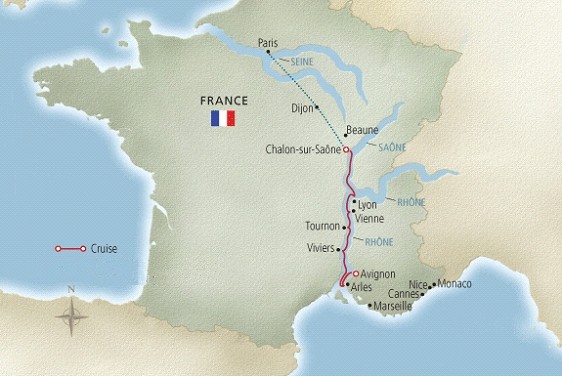
|
April 13: Day 1
|
Sunday |
Avignon |
|
April 14: Day 2
|
Monday |
Arles |
|
April 15: Day 3
|
Tuesday |
Avignon & Viviers |
|
April 16: Day 4
|
Wednesday |
Tournon |
|
April 17: Day 5
|
Thursday |
Vienne & Lyon |
|
April 18: Day 6
|
Friday |
Lyon |
|
April 19: Day 7
|
Saturday |
Burgundy Wine Tour & Beaune |
|
April 20: Day 8
|
Sunday |
Chalon-sur-Saône |
After the trip concludes, why
not consider extending your trip on through Paris,
one
of the world's most romantic cities? |
|

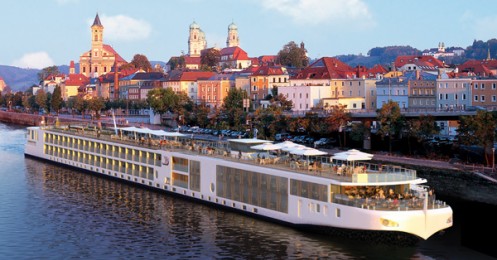 |
A Note from Marla:
Please come join the SSQQ Travel
Group on our first river cruise.
Our first river adventure takes us to the scenic
Rhône
and
Saone Rivers
in the southern part of France.
As we sail aboard the
Viking Hermod, Viking's
newest longship, we will
explore the famed region of Burgundy and the lavender fields
of Provence. During our
7-day journey in mid-April next year, our
ship will pass some of the
most beautiful vistas the French countryside has to offer.
This trip has been named "Portraits of
Southern France" for an obvious reason. Our very first
port of call is to Arles, home of Vincent Van Gogh, a
true
genius of the art world.
Our
trip will begin in style as we walk the cobbled
streets in Arles on the Vincent
Van Gogh Walking Tour.
There are many other
highlights
on this trip. After the Van Gogh Tour, we will have a visit
to Gallo-Roman ruins in both Vienne and Arles.
And we will have a visit to the historic Papal
Palace in Avignon, "City of the
Popes".
Of course we
will learn about the region's time-honored winemaking
traditions and sample Burgundy
wines in one of France's most famous wineries.
In Lyon we will have the privilege to appreciate the
city's world-famous cuisine. C'est magnifique!
Included Features:
-
8 day cruise with a
river-view stateroom
-
6 guided tours with
Quietvox Tour Earphones
-
All
meals: 7 breakfasts, 6 lunches, 7 dinners
with regional specialties
-
Complimentary wine at lunch
and at dinner
-
Welcome
Cocktail Reception and Dinner
-
Captain's
Farewell Dinner
-
Visits
to 3 UNESCO World Heritage Sites
-
A
Culture Curriculum that includes performances of
traditional French music, tours of Roman ruins, French
language lessons, French winemaking demonstrations and
wine tasting, a French cuisine workshop,
and "The
Painter's Muse",
a
lecture on the art of France
Best
of all, we will have the joy of
sharing this with friends!
|
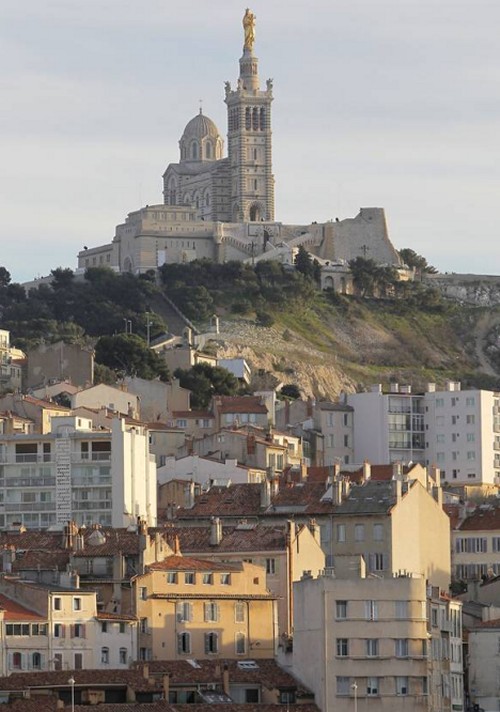 |
| |
|
Day 1:
Sunday, April 13th: Avignon
|
Our trip begins in Avignon.
Our
cabins will not be
available until
3 pm, so this gives us plenty of
free time to
explore Avignon on our first day.
The evening will include a Welcome
Aboard Cocktail Reception and Dinner
About Avignon:
In the Middle Ages, the Saint Bénézet bridge was part of one
of the most important pilgrimage routes between Italy and
Spain. It would become essential to the pontifical court,
which settled in Avignon in the 14th century.
Very soon, the cardinals moved to Villeneuve to escape the
pollution of Avignon, at the time described by the poet
Petrarch as the "most foul and stinking city on Earth".
The bridge was at that time the most
direct link between the many residences that the
cardinals had had built, and the Popes' Palace
situated inside Avignon's city walls.
The bridge of Avignon
was started in 1177. It
was over 36,000 feet long, it had 22 arches and
measured 13 feet wide.
This imposing edifice, that was called the marvel
of the time, was built in only 8 years, taking until 1185.
The narrowness of the bridge of Avignon contradicts the
famous song: "on the bridge of Avignon" one could not "dance
round and round"; it seems more likely that one danced under
the bridge, as an inn had been set up on the Ile de la
Barthelasse, at the foot of one of the small arches.
Before the bridge,
people crossed the Rhône in small boats, and this river that
Man had not yet domesticated often made the crossing quite
perilous. Arles having lost its Roman bridge, that of
Avignon became the only place between Lyon and the
Mediterranean to cross the Rhône. The city attracted
travelers, merchants and manufacturers and quickly developed
thanks to the revenue generated by the tolls. Without doubt,
it had also worked in Avignon's favor when the popes made
the decision to settle there in the 14th century.
In 1226, after the terrible siege to which Louis VIII
subjected the city, three quarters of the bridge was
destroyed. A few years later, despite it being forbidden,
the people of Avignon put themselves to the task and rebuilt
it. From the former bridge only the chapel remains and is
called the lower chapel because the roadway of the second
bridge was raised and so the newer St Nicolas Chapel built
on it is called the higher chapel.
From the 17th century on, the
city could no longer bear the costs of the bridge's
maintenance and repairs. In 1603, following strong flooding
of the Rhône, one arch collapsed, then three others in 1605.
Repair work didn't start until1628, interrupted by an
epidemic of plague, and the bridge was not usable again
until 1633. Two months later, two new arches were swept away
by the Rhône.
At that time, diverse means
were used to cross the river. An island, today called Ile de
la Barthelasse, formed in the middle of the river bed.
People left from the Philippe le Bel tower, situated in
Villeneuve-lés-Avignon in the French kingdom (on the right
bank of the Rhône), crossing to the island by ferry. They
then crossed the island on foot following a path which led,
by way of wooden stairs, to the bridge's 4 remaining arches
to finally reach the city of Avignon.
The
bridge of Avignon threatened so much to collapse that the
relics of Saint Bénézet were taken from the St Nicolas
Chapel in 1674. They were transferred to the Celestine
cloister. After being moved several times and a desecration
in 1791, there remained just a few bits from the mortal
remains, which are now kept in the cathedral of
Notre-Dame-des-Doms.
Of the
bridge itself,
there only remains the four famous arches and the Philippe
le Bel tower on the Villeneuve-lès-Avignon side, and of
course, the famous song known around the world
The Place
of the Popes
(a papal residence, fortress, church and palace) will
await our exploration in
Avignon. Built in less than twenty years, starting in 1335,
it is the biggest Gothic Palace in Europe, covering almost
50,000 square feet and is renowned for its rambling maze.
Oh, what fun we will have getting lost in that maze! I can
see Rick now.
The private
papal apartments and the stunning frescoes painted by the
Italian artist Matteo Giovannetti are just some of the many
other highlights to uncover.
The Palace is
actually made up of two buildings: the old Palace of
Benedict XII which sits on the impregnable rock of Doms, and
the new Palace of Clement VI, the most extravagant of the
Avignon popes. Not only is the final combination the largest
Gothic building of the Middle Ages, it is also one of the
best examples of the International Gothic architectural
style.
Due to its immense size, the Palace was also the place where
the general organization of the Church began to change. It
facilitated the centralization of services and the adaption
of operations in order to suit the needs of the papacy,
creating a truly central administration for the Church.
Despite all its achievements, the Palace became obsolete
when the papacy found it necessary to return to Rome.
Avignon
became the home of the popes in 1309, who were fleeing the
violent chaos of Rome. The Palace was built between 1335 and
1364 on a natural rocky outcrop at the northern edge of
Avignon, overlooking the river Rhône. The site was formerly
occupied by the old Episcopal palace of the bishops of
Avignon.
The Palais
des Papes was built in two main phases with two distinct
segments, known as the Palais Vieux (Old Palace) and Palais
Neuf (New Palace). By the time of its completion, it
occupied an area of 2.6 acres. The building was enormously
expensive, consuming much of the papacy's income during its
construction.
The Palais
Vieux was constructed by the architect Pierre Poisson of
Mirepoix at the instruction of Pope Benedict XII. The
austere Benedict had the old Episcopal palace razed and
replaced with a much larger building centered on a cloister,
heavily fortified against attackers. Its four wings are
flanked with high towers.
Under Popes
Clement VI, Innocent VI and Urban V, the building was
expanded to form what is now known as the Palais Neuf. Jean
de Louvres was commissioned by Clement VI to build a new
tower and adjoining buildings, including a 52m-long Grand
Chapel to serve as the location for papal acts of worship.
Two more
towers were built under Innocent VI, and Urban V completed
the main courtyard (known as the Court d'Honneur) with
further buildings enclosing it. The interior of the building
was sumptuously decorated with frescos, tapestries,
paintings, sculptures and wooden ceilings.
The popes
departed Avignon in 1377, returning to Rome, but this
prompted the Papal Schism during which time the antipopes
Clement VII and Benedict XIII made Avignon their home until
1408. The latter was imprisoned in the Palais for ten years
after being besieged within in 1398. The building remained
in the hands of antipapal forces for some years – it was
besieged from 1410 to 1411 – but was returned to the
authority of papal legates in 1433.
Although the
Palais remained under papal control (along with the
surrounding city and Comtat Venaissin) for over 350 years
afterwards, it gradually deteriorated despite a restoration
in 1516. When the French Revolution broke out in 1789 it was
already in a bad state when it was seized and sacked by
revolutionary forces. In 1791 it became the scene of a
massacre of counter-revolutionaries, whose bodies were
thrown into the Tour des Latrines in the Palais Vieux.
The Palais
was subsequently taken over by the Napoleonic French state
for use as a military barracks and prison. Although it was
further damaged by the military occupation – the frescos
were covered over and largely destroyed – ironically this
ensured the building's physical survival. It was only
vacated in 1906, when it became a national museum. It has
been under virtually constant restoration ever since.
The majority
of the Palais is now open to the public; it also houses a
large convention centre and the archives of the department
of Vaucluse.
There is
an optional tour to Châteauneuf-du-Pape, visiting the
vineyards and tasting the famous wine.
|
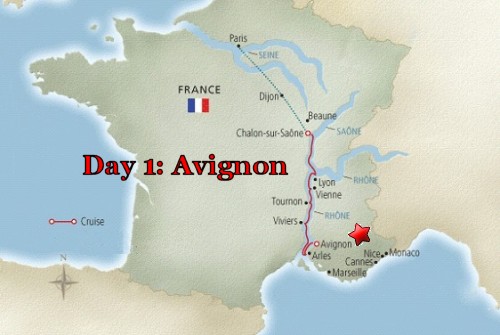
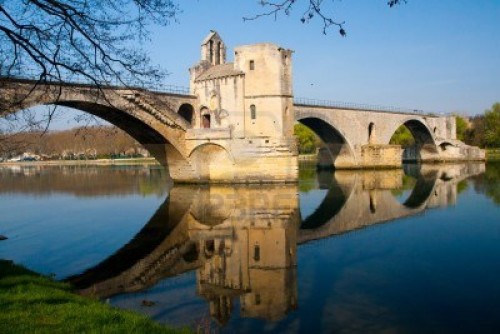
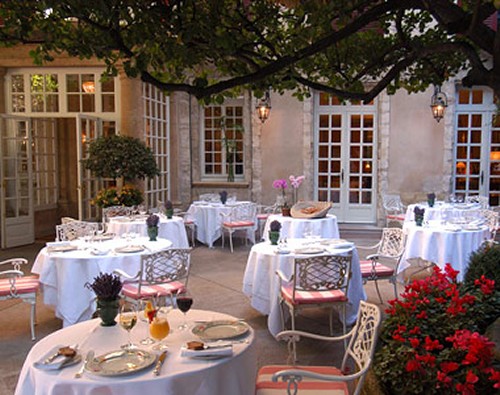
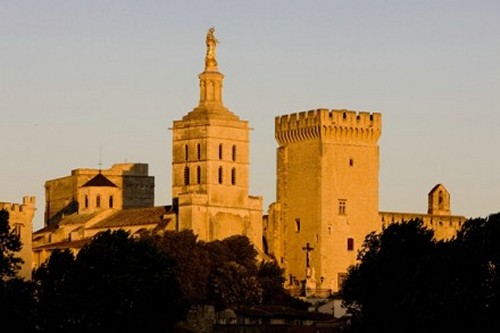
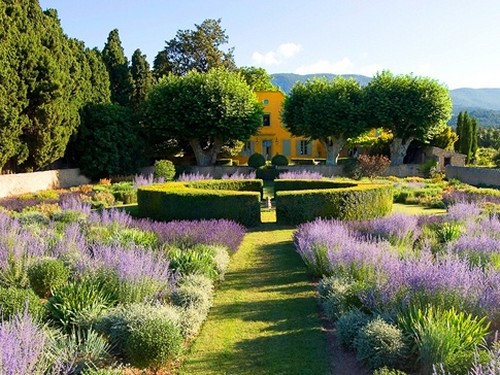
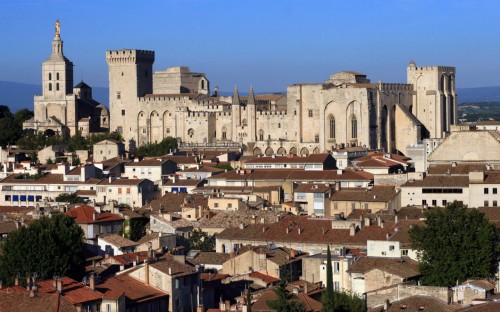
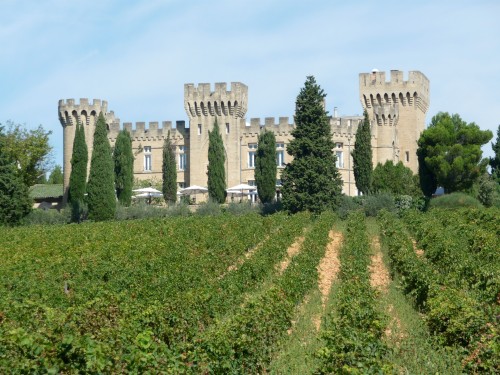
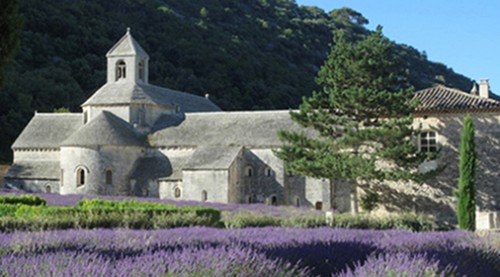 |
| |
|
Day 2:
Monday, April 14th:
Arles
|
Every day there is a tour of each city sponsored by the
ship. When we visit Arles, we will take a guided walk
that includes Les Arenes
and Church of Saint Trophime.
Arles, of
course, is famous as the home of Vincent Van Gogh.
This town is where Van Gogh drew most of his famous
paintings.
Vincent Van Gogh
arrived in Arles in 1888 and stayed until his
breakdown in 1889. Van Gogh
found inspiration in the vibrant light and local landscape
and produced over 300 paintings during his time there. His
works from the period are richly draped in yellow,
ultramarine and mauve. Vase with Twelve Sunflowers
and Van Gogh's Chair were both completed there in
1888.
As it happens,
there are several locations in Arles that allow you to see
the exact spot where Van Gogh drew several of his pictures.
The "In His Steps"
Walking Tour takes you to these various spots in the
town itself.
For example,
here is Van Gogh's original
Café Terrace
painting plus the exact spot
as it appears in Arles today.
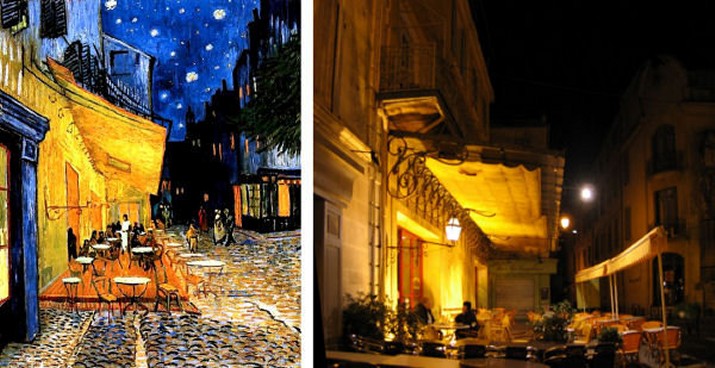
How cool is it
to see the places that inspired many of his paintings?
The visitor's center in Arles
provides a walking tour map of ten reproductions on easels
depicting actual places throughout Arles including:
Starry Night Over the Rhône and Café Terrace on the
Place du Forum, Arles at Night.
Certainly our
tour will visit the Van Gogh Gallery and we will have time
to go back for more in the afternoon during our free time.
There is quite a
bit of history about Arles.
Arles is a great example of the adaptation of an ancient
city to medieval European civilization. Arles has some
impressive Roman monuments, of which the earliest - the
arena, the Roman theatre and the cryptoporticus
(subterranean galleries) - date back to the 1st century B.C.
During the 4th century Arles experienced a second golden
age, as attested by the baths of Constantine and the
necropolis of Alyscamps. In the 11th and 12th centuries,
Arles once again became one of the most attractive cities in
the Mediterranean. Within the city walls, Saint-Trophime,
with its cloister, is one of Provence's major Romanesque
monuments.
Arles is an especially significant example of the
appropriation of a classical city by a medieval European
civilization. The town, founded by the Phoceans in the 7th
century BC as Arelate, owed its prosperity to the decline of
its rival, Marseilles, under the Emperor Augustus. It has
retained impressive Roman monuments of which the earliest,
the Arena, the Roman Theatre, and the Cryptoporticus
(subterranean galleries) date back to the 1st century BC.
During the 4th century, Arles rose to the rank of political
capital and religious metropolis; testimony to this second
golden age is provided by the Baths of Constantine and the
superb marble sarcophagi of the Alyscamps cemetery. However,
in 480 the city fell into the hands of barbarians.
The subsequent decline was a cruel one for the city, which
did not regain its role as a capital until the 9th century
with the creation of an independent kingdom. Successively a
territory of the Empire and a possession of the Counts of
Provence, Arles was one of the most attractive cities of the
Mediterranean world during the Middle Ages.
The Roman theatre was built at the end of the 1st century
BC. The cavea could hold 10,000 people in 33 rows of seats.
The majestic high wall at the back of the stage was
decorated with columns and statues; two columns and the
collection of sculptures are in the Arles Archaeological
Museum. From the 5th century onwards, the theatre was
occupied by houses and religious buildings, which were
demolished starting in 1834. At that time the semi-circular
orchestra section with its precious marble pavement, the
space occupied by the machinery used to raise and lower the
curtain, part of the seats, and parts of the outer wall
preserved in the Tower of Roland during the Middle Ages were
restored and conserved.
The amphitheatre, built around AD 90, ranks among the great
amphitheatres and could hold 20,000 spectators. Gladiator
fights and animal hunts took place here until the end of the
5th century. During the Middle Ages, the building became a
fortress, sheltering two chapels and 212 houses within its
walls. These parasitic constructions were destroyed in 1825.
The underground passages of the Cryptoporticus were used as
foundations for the Roman forum, the political, commercial,
and religious centre of the Roman city.
They were built in 30 BC on the
side of the hill, and their construction necessitated
gigantic earth filling and leveling operations. The U-shaped
Cryptoporticus is made up of three double corridors covered
with barrel vaults. They intersect at right angles and are
separated by rows of massive pillars supporting
basket-handle arches. Towards the end of the Roman Empire
shops were built, opening on the outer side.
In Roman times Arles was surrounded by graveyards, including
one situated along the Via Aurelia which later became known
as Les Alyscamps. This cemetery subsequently became
important when the Christian martyr Saint Genest and the
first bishops of Arles were buried there. In 1040 the site
became the Saint-Honorat priory, one of the required stops
on the pilgrimage route to Santiago de Compostela in Spain.
Today a path lined with numerous
sarcophagi, painted by Van Gogh and Gauguin, leads to the
church of St Honorat at the far end. The latter was rebuilt
during the 12th century in Romanesque style and crowned with
a splendid octagonal lantern inspired by the architecture of
the Roman amphitheatre. The church of Saint Trophime and its
cloisters constitute an exceptional Romanesque group,
strongly influenced by ancient art.
Beside the Rhône the Baths of Constantine were built during
the 4th century as part of a complex including several
buildings. Still visible today are the hot rooms, the pools,
the ventilation system for the hot air circulating within
the walls through hollow tiles and between the piles of
bricks.
The walls, consisting of alternating rows of bricks and
small worked limestone blocks, are built around a
semi-circular apse which was lit by three high round-arched
windows, and covered with a magnificent quarter-sphere vault
Towards the south were located the warm baths, the cold
baths, and gymnasium.
|
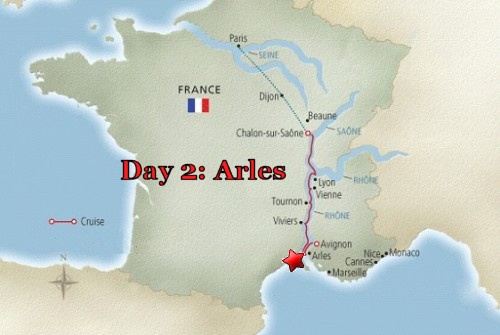
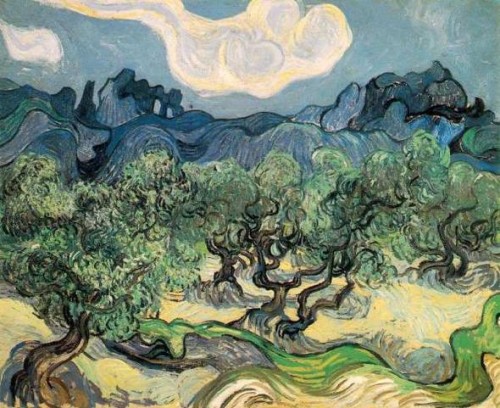

Today's
Langlois Bridge
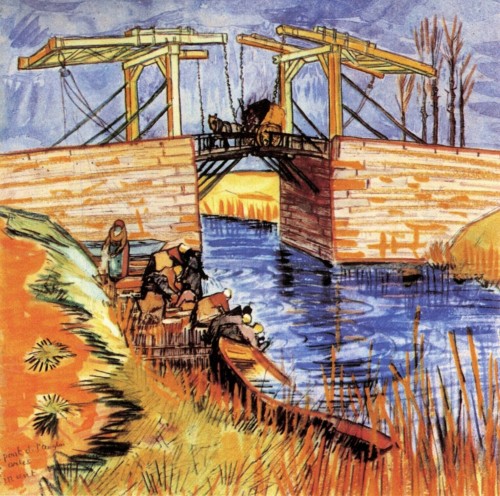
Langlois
Bridge drawn by Van Gogh
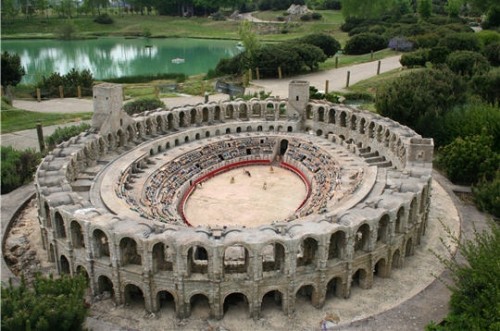
 |
| |
|
Day 3:
Tuesday, April 15th:
Avignon and Viviers
|
After Arles, we return to Avignon.
Today's tour will include a Guided
walk of Avignon including Pont d"Avignon and Place de
l'Horloge, Palace of the Popes.
There is an optional tour of
Chateauneuf-du-Pape winery.
We will be in two places today.
Late in the day our ship will take us upriver to Viviers.
Our evening will include a romantic stroll through
the Old Town in Viviers
The History of Viviers
Marla's Note: When I saw the
pictures of Viviers, I absolutely fell in love with the
place. The word "picturesque" was surely coined with
this quaint little town in mind.
In the evening, our ship will tie
up at a little wharf alongside this very sleepy city!
Viviers is an amazing little town.
Viviers is located in the French Department of
Ardeche. A small walled city, Viviers nuzzles between the
hills behind and the bank of the Rhône.
Viviers
in late Roman times was capital of the pays Vivarais and
today, it is still the see of the bishop of Ardeche, with
the diocese including the Department of Ardeche.
It was suppressed by the Concordat of 1802, and united to
the See of Mende, re-established in 1822.
The "Old Charter", drawn up in 950 by Bishop Thomas, the
most complete document concerning the primitive Church of
Viviers, mentions five bishops, who lived at Alba Augusta
(modern
Aps): Saint Januarius, Saint Septimus, Saint Maspicianus,
Saint Melanius, and Saint Avolus, the last a victim of the
invasion of the barbarian Chrocus (the exact date of which
is unknown).
After the
ravages suffered by Alba Augusta, the new bishop, St.
Auxonius, transferred the see to Viviers about 430 and
promotus was probably the first Bishop of Viviers, documents
also mentioning later several canonized bishops; Saints
Lucian and Valerius (fifth and sixth centuries); St.
Venantius, disciple of St. Avitus, who was present at the
councils held in 517 and 535; St. Melanius II (sixth
century); St. Eucherius, St. Firminus, St. Aulus, St.
Eumachius, St. Longinus (seventh century); St. Arcontius,
martyr (date unknown, perhaps later than the ninth century.
It seems that the Diocese of
Viviers was disputed, for a long time, by the metropolitan
Sees of Vienne and Arles, but from the eleventh century its
dependence on Vienne was not contested and John II, cardinal
and Bishop of Viviers (1073-95), had the abbatial church of
Cruas consecrated by Urban II, and accompanied him to the
Council of Clermont.
In the thirteenth century, under
the reign of St. Louis of France, the Bishop of Viviers was
obliged to recognize the jurisdiction of the Seneschal of
Beucaire and by the treaty of 10 July, 1305, Philip IV of
France obliged the bishops of Viviers to admit the
suzerainty of the kings of France over all their temporal
domain.
Several saints are connected with
the history of the diocese; the Spanish deacon and martyr,
St. Vincent (end of third century), protector of the
cathedral church and of the diocese; St. Just, Bishop of
Lyons (end of the fourth century), belonging to the family
of the Counts of Tournon; St. Montan, hermit (fifth
century); St. Ostianus (sixth century), confessor, a
relative of Saint Sigismund, King of the Burgundians; the
Blessed Amadeus, founder of the Benedictine Abbey of Mazan
(d. 1140); St. Benezet, shepherd (1165-86), builder of the
bridge of Avignon, b. in Vivarais; the Blessed Guigues I,
fifth prior of the Carthusian mother house Grande
Chartreuse, friend of St. Bernard, and writer of the "Statuta
ordinis Carthusiensis" (twelfth century); St. Francis Regis.
Viviers has been a very significant
location for the Catholic Church through the ages -" to see
the amazing Viviers and its historic buildings
|
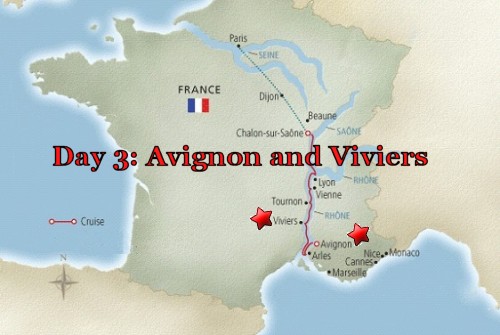
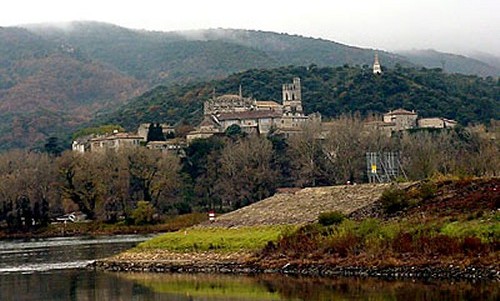
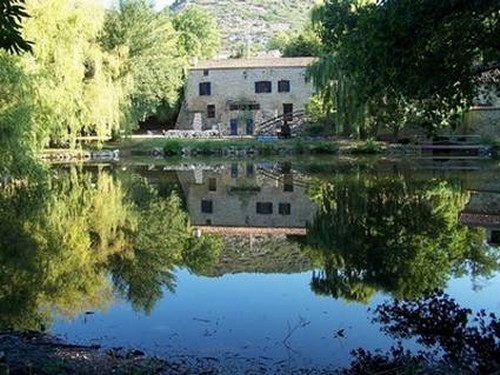
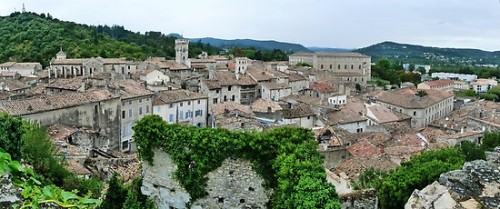 |

Viviers |
| |
|
Day 4:
Wednesday, April 16th:
Tournon
|
Our guided Tour of Tournon
will take us through the town plus a
visit to the Musee de Tain l'Hermitage
About
Tournon: Tournon
acts as a gateway to the Ardeche and lies at the foot
of granite hills which rise up from the Vallee du Doux.
A pretty town with wide tree-lined avenues, it is proud of
its historical heritage and 11th-16th-century chateau, which
houses a museum of local history.
To the north of the Grand Rue on Place, lies Collegiale
St Julien with its imposing bell tower. It serves as an
example of the Italian influence on architecture in the area
in the 14th-century.
Tournon is a great place to sample some of the delights of
the Ardeche such as roasted chestnuts. Across the river
you'll also be able to visit the village of Tain
l'Hermitage with its steeply vineyards producing some of
the most costly of the Cotes du Rhône wines (white and red
Hermitage).
Tournon is also the ideal spot for outdoor enthusiasts with
walkers, cyclists and riders being richly rewarded by the
surrounding countryside.
It's main attraction is a 10th Century feudal castle which
is built into a rock overlooking the town and the river. The
castle has a section built in the Renaissance, that houses
the town museum.
We will take a tour through Tournon to Tain l’Hermitage, a
region known for its wine and gourmet chocolate. During a
guided tour of the area, we will learn about the region’s
winemaking traditions and taste some famous regional red
wines.
Then we will visit the Musée de Tain l’Hermitage, located in
the oldest house in the region
|
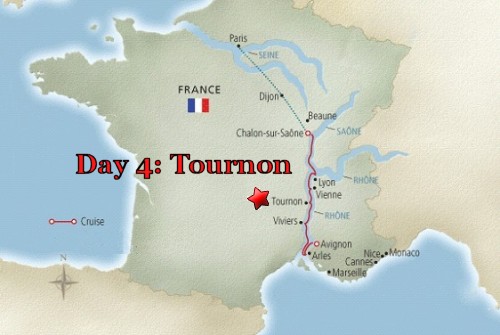
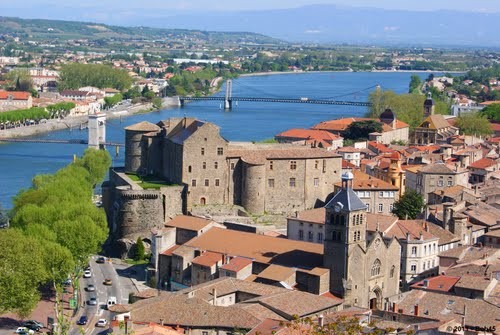 |
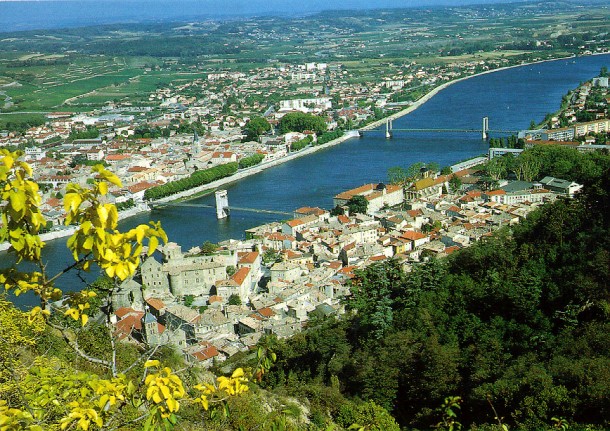 |
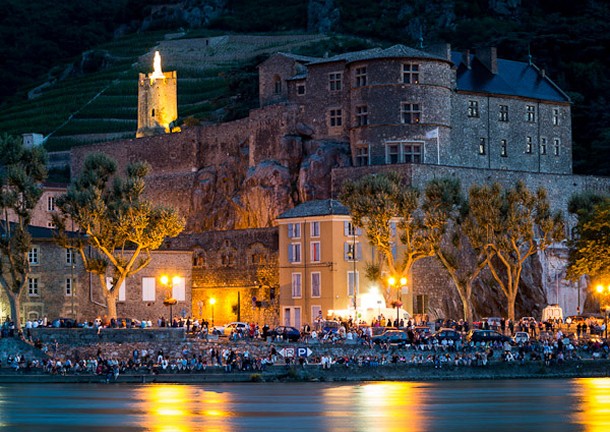 |
| |
|
Day 5: Thursday,
April 17th:
Vienne and Lyon
|
We will be in two different towns today.
In the daytime we visit Vienne. Then late in the
afternoon we will sail up the river to Lyon, one of the
highlights of our trip. We will dock in Lyon and stay
the night so we can visit more of Lyon on Day Six.
During our stay in Vienne, the ship will
take us on Walking tour of the
town. The tour will include
the Temple of Augustus and Livia,
a Roman amphitheater and the
Goth Cathedral of St.
Maurice
About Vienne
--
Like Viviers the day before, Vienne is a
remarkably pretty town. It sits on the left bank of
the Rhône River about 30 miles south of Lyon.
Vienne's recorded history dates back to the third century AD
when a Gaulish tribe, the Allobroges lived where Vienne now
stands. After the Gallic wars Vienne became a Roman colony
(this was coveted at the time as it this gave the residents
of Vienne the same rights as Romans) thanks to Vienne siding
with the winning Romans and strategic location. Vienne also
was a residence of Roman emperors.
After the
fall of Rome Vienne became part of the Kingdom of Burgundy.
During this time Christianity flourished and a number of
churches and monasteries on both sides of the Rhône River
were built. In the 9th century Vienne became the capital of
Provence until being absorbed into the Holy Roman Empire
during the 11th century.
This did not undermine the
influence of Vienne as one of its archbishops; Gilsa de
Bourgogne was elected Pope in 1119 and became Calixtus II.
In 1450 Vienne became a part of France and thus was soon
overtaken by Lyon in size and power.
The Roman
influence on Vienne is easily spotted during a walk through
the town center. There is the Roman Theater, the second
biggest in France, today home to a yearly Jazz festival; a
temple dedicated to the Rome cult Augustus, the ruins at
Cybele Garden once a Roman neighborhood.
There are two outstanding Roman remains: the temple of
Augustus and Livia; and the Plan de l'Aiguille or
La Pyramide, a truncated pyramid resting on a portico
with four arches, which was associated with the city's
Roman circus.
Just across
the Rhône River is one of the largest Gallo-Roman
archaeological sites in France at Saint-Romain-en-Gal.
Saint-Romain-en-Gal was once a neighborhood of Vienne.
Vienne also
has a number of churches including a cathedral –
Saint-Maurice and Saint-André-le-Bas once home to an abbey
with 12th century cloisters.
The best
view of Vienne and the Rhône River can be found atop Le Mont
Pipet just above the Roman theater. Le Mont Pipet is one of
the five hills surrounding Vienne. Another of the five hills
Mount Soloman, to the north of Le Mont Pipet, is home to the
ruins of the once a chateau La Bâtie.
|
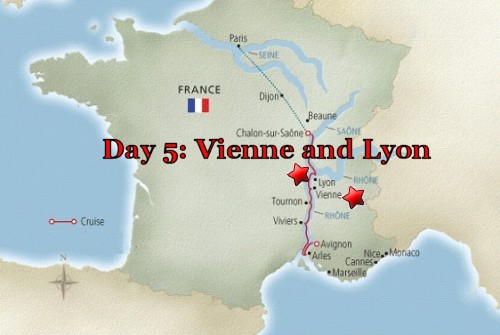
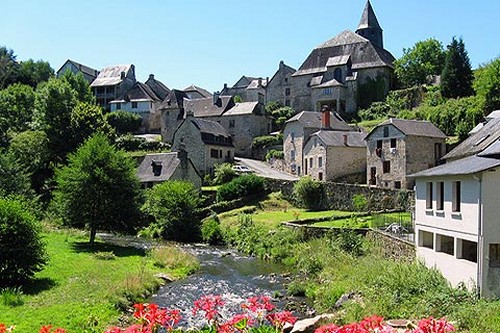
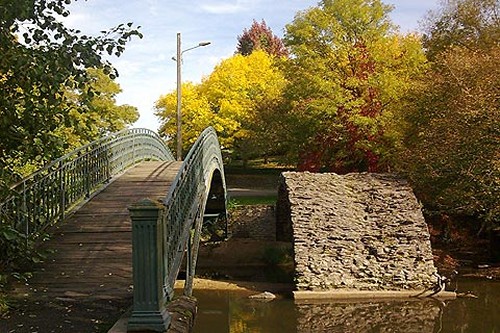 |
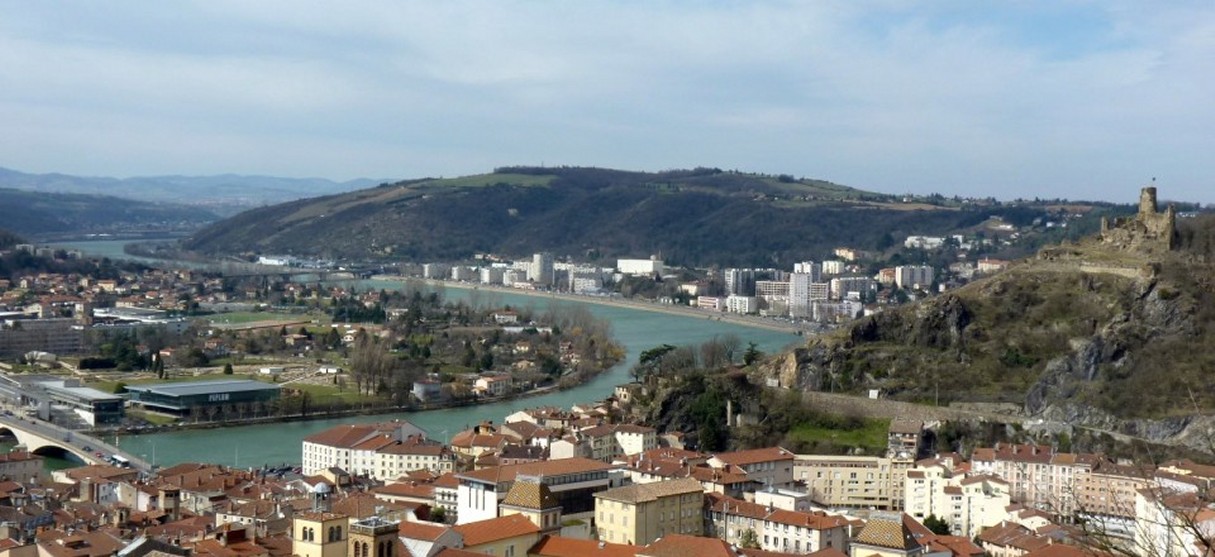
Vienne |
| |
|
Day 6:
Friday, April 18th:
Lyon
|
Our tour of Lyon
will include the Basilica of Notre Dame, St. Jen
Cathedral and Palace of Justice.
The tour will begin with a drive
to the top of Fourvière Hill for amazing views of the city.
We will continue with a guided visit to the Basilica of
Notre Dame and a drive through town past the magnificent St.
Jean Cathedral and the Palace of Justice. We will then take
a walking tour through the cobbled streets of
Vieux
Lyon (Old Town), with free time to shop for
souvenirs or sample some of the fine French cuisine for
which Lyon is world-famous.
About Lyon
--
A place
of splendid history, fascinating museums and exciting
attractions, the landmark status of Lyon, France was
famously recognized by UNESCO in 1998 as a World Heritage
Site. The designation pays tribute to the rare collection of
historic sites in Lyon. Home to Europe's largest intact
Renaissance district, Lyon offers an exploration through
thousands of years of history, from Roman theatre ruins of
ancients times to Contemporary.
It is
also a commercial,
industrial and banking powerhouse for the past 500 years,
grand old Lyon (Lyons in English) is the focal point of a
prosperous urban area of almost two million people, France's
second-largest conurbation. Outstanding art museums, a
dynamic cultural life, a busy clubbing and drinking scene,
not to mention a thriving university and fantastic shopping,
lend the city a distinctly sophisticated air.
Green parks,
riverside paths and a historical old town sufficiently
precious to be protected on Unesco’s World Heritage list
ensure a bounty of discoveries on foot or bicycle – for the
first-time visitor, while adventurous can indulge their
wildest gastronomic fantasies in a dining scene that is
chic, sharp and savvy.
Vieux Lyon -
Vieux Lyon is without doubt the most famous and most visited
area of the town, especially since its classification as a
world heritage centre by UNESCO. Beside the Palais épiscopal
Saint Jean and the Cathédrale Saint Jean, you will find many
townhouses which date from the middle ages and the
Renaissance: the Maison du Soleil (Saint Georges quarter),
the Tour rose, the Auberge du Gouvernement, the Maison
Thomassin, the Hotel Laurencin, the Maison des avocats, the
famous Cour des Loges hotel, the Maison du Chamarier (Saint
Jean quarter), and the Hôtel
Paterin.
The Hôtel Bullioud
is where the architect Philibert
Delorme built his famous trompe l'oeil gallery (Saint Paul
quarter). From the Middle Ages the area was reserved for
trade and fairs, as shown by the Loge du Change, which was
once a bank and then became a Protestant place of worship.
Fans
of architecture will be delighted to pace the paved alleys
and the traboules - these famous passages link alleyways
together and through them you can explore the interior
courtyards of the townhouses. Those fond of archaeology will
be interested in the remains of the primitive cathedral in
the Jardin archéologique situated at the north side of the
present day sanctuary. Old Lyon (Vieux Lyon) has an
undeniable charm, with its boutiques, its 'bouchons'
(restaurants which specialize in Lyonaise cuisine) and its
colours, which make you think of Italy.
|
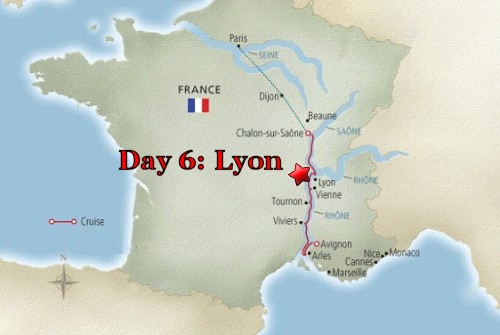
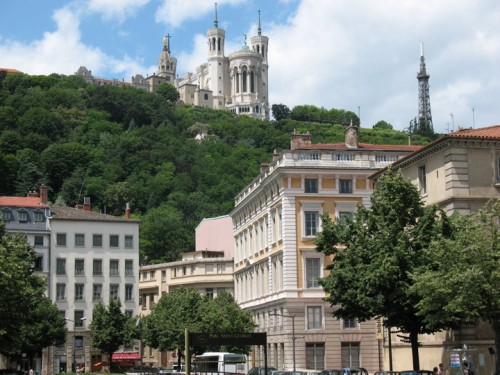
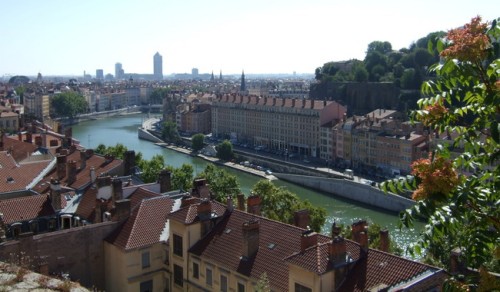 |
| |
|
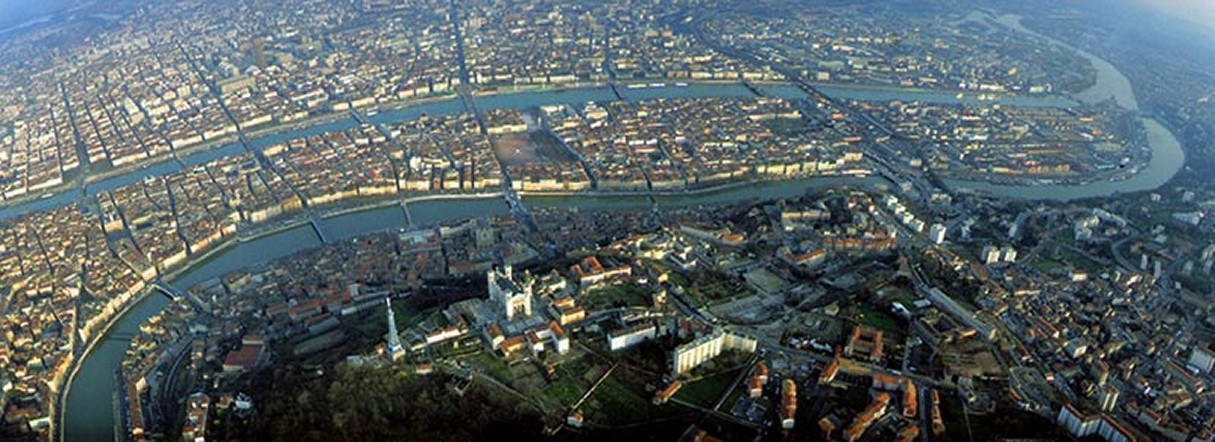
Lyon where
the Rhône and the Saone Merge |
| |
|
Day 7:
Saturday, April 19th: Burgundy
Wine Tour - Beaune
|
Today's tour includes a scenic drive along France's
Burgundy wine route.
We
will then have a tour of Beaune
including Hotel Dieu with wine tasting.
In the evening we will float back down
the river to Chalon-sur-Saone
with free time to visit the city.
Tonight will feature the
Captain's
Farewell Dinner
About Beaune:
Beaune is one of the key wine centers in France. The town is
surrounded by some of the world's most famous wine villages,
while the facilities and cellars of many producers, large
and small, are situated in Beaune itself. With a rich
historical and architectural heritage, Beaune is considered
the "Capital of Burgundy wines.
It is an
ancient and historic town on a plain by the hills of the
Côte d'Or, with features remaining from the pre-Roman and
Roman eras, through the medieval and renaissance periods and
up to recent history and modern times.
Beaune is a
walled city, with about half of the battlements, ramparts,
and the moat, having survived and in good condition, and the
central "old town" is extensive. Historically Beaune is
intimately connected with the
Dukes of Burgundy.
Beautiful
Beaune has much to offer to its visitors. Dating back more
than 2,000 years, it has been crowned the Capital of
Burgundy Wines and boasts the stunning Hotel Dieu, a former
charitable almshouse built in 1443. A splendid example of
French Gothic architecture with an intricate tiled roof, it
is also one of Beaune's best cellars and owns 150 acres of
vineyard land.
Our excursion will be a scenic drive
along France’s Burgundy wine route through Pommard, Volnay
and Meursault. We will then arrive in Beaune, wine capital
of Burgundy, for a guided tour of beautiful Hôtel Dieu,
founded as a hospice in 1443. We will learn about local
viticulture and enjoy a wine-tasting at one of Beaune’s
famous cellars.
We will sample a number of regional wines and learn more about the story
of wine in this amazing building.
|
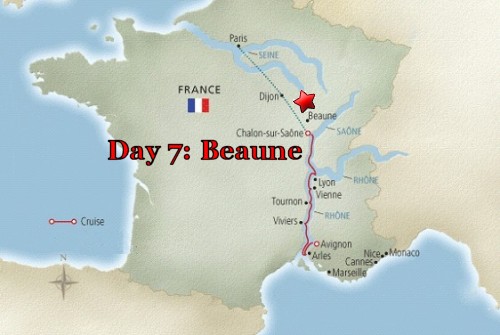
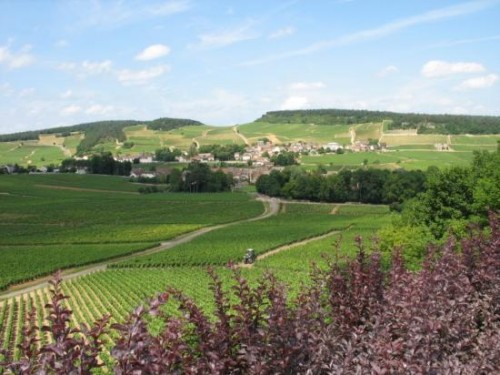 |
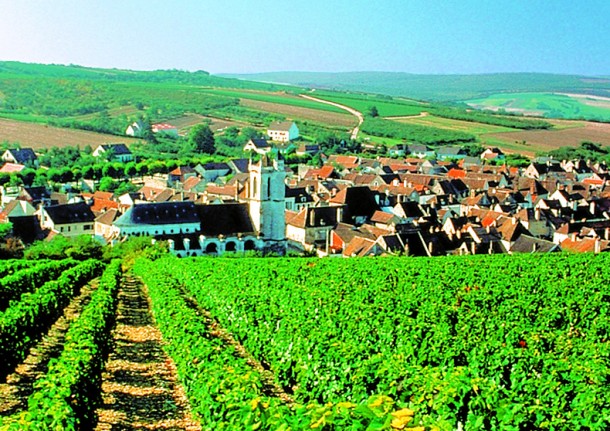 |
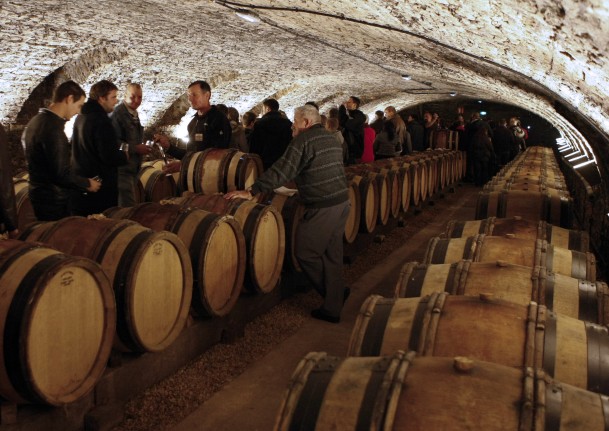 |
| |
|
Day 8: Sunday,
April 20th: Chalon
sur Saone
|
Chalon is a major wine growing
area. Famous wines such as Mercurey, Givry, Montagny and
Rully come from here. Visit the Maison des Vins de la Côte
Chalonnaise at 2 Promenade Ste-Marie to sample these fine
wines.
No visit to
Burgundy would be complete without wine-tasting, the Maison
des Vins, has a large selection of carefully selected local
wines to taste (and buy).
This is a lively town on the River Saone with a market three
times a week at the Place St-Vincent. The cathedral square
has a café society with Le Moulin à Cafe and speciality
shops such as Légendes Gourmandes. There are fine
half-timbered houses overlooking the Place; Rue de Châtelet
and Grande Rue are worth visiting also to see 17th and 14th
century facades. The cathedral itself is a good example of
Romanesque architecture.
There is a
large and mostly pedestrian center with the old streets
containing a very wide range of shops and cafes, and some
individual properties of interest such as one or two
medieval half-timbered houses, the Palais de Justice and
others tucked away up side-streets.
Be sure to
stop and visit the large open square in front of the Town
Hall where you can see various buildings of interest, and a
chance to sit in the sunshine at a street-side cafe watching
the world go by before you depart. Among the notable
buildings are the town hall itself, the large baroque style
Church of Saint-Pierre, and the Museum Denon.
The bakery, La Meuliere,
in Rue Général Leclerc is a particular favorite for whole
cereal breads, biscuits, jams and cheesy wafers for apéros.
Another
imposing religious monument in Chalon-sur-Saone is the
Cathedral Saint-Vincent in the Place du Marché, originally
the centre of the medieval city. Dating in part from the
11th century the facade of the cathedral was added in the
19th century.
Inside the
cathedral you can see some ornate stone arches, medieval
frescoes and cloisters. There are also some attractive
half-timbered houses to be seen around the edges of the
Place du Marché
If you are interested in photography,Joseph Nicephore-Niepce
who invented the first photograph was born in Chalon in
1765. A museum dedicated to him is housed in the Hôtel des
Messageries on the banks of the Saône. Apart from cameras,
it has a fine photographic collection on display tracing the
history of photography. Along the Quai, the Atelier St-Jean
there is an art gallery with exhibitions by prominent
artists.
|
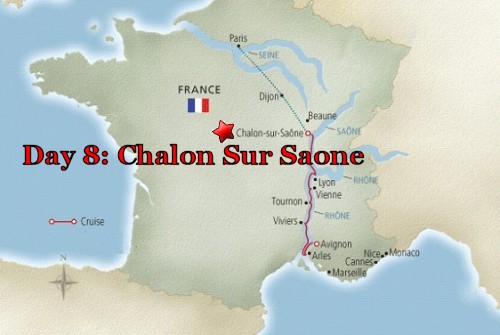
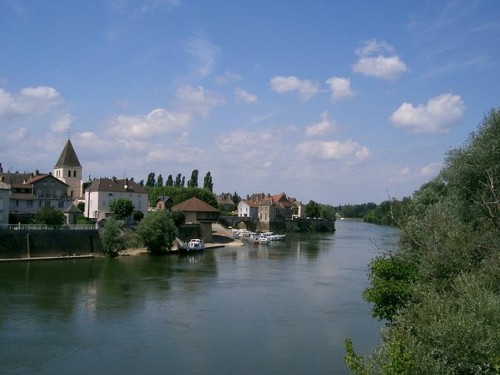 |
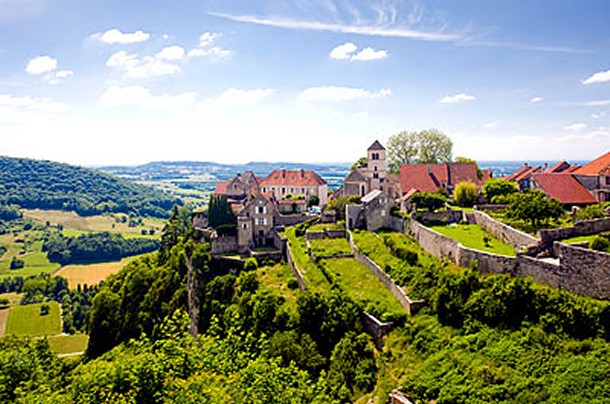 |
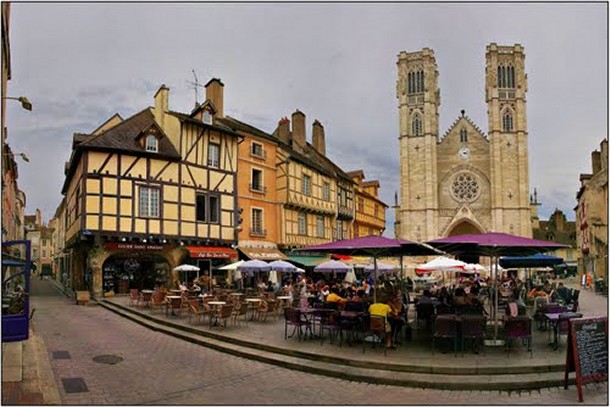 |
| |
|
Post
Cruise:
Paris
|
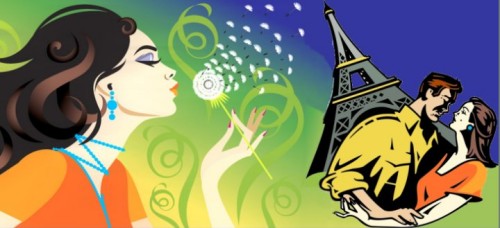 |
|
Marla's
Note:
To be honest, I
haven't decided what I want to do about Paris just yet.
You can assume
Rick and I are headed to Paris.
Perhaps those of
us who want to continue on can stay in a hotel together and
take it from there. We can all scatter through the
city by day and regroup at night to do things together.
More info to
come.
Incidentally, if
you are interested in a trip to Paris, be sure to read
Rick's stories about
Paris from our Oslo 2010 Trip.
And definitely
check out Rick's story about our trip to
Southern France that was part of the 2009 Barcelona
Cruise. Rick's story gives you a preview look at the
fabulous countryside that we will be visiting. It was
the beauty of this particular visit that created my desire
to go back and see more.
|
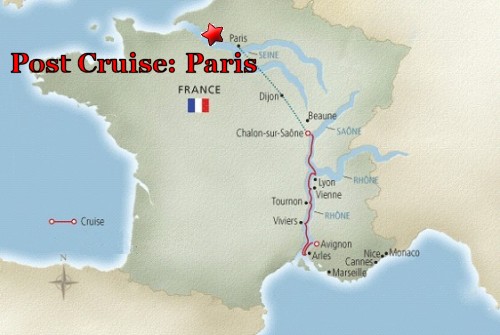 |
Cruise
Critic Editors chose Viking as the Best River Cruise line in
2012. In his words,
"Viking River Cruise Line’s Longships are the best new
river ships. The six new
Viking Longships launched this year (2012) are
identical, so all win for their sleek lines, stunning
atrium, balcony cabins with full-sized verandahs, and
hotel-style suites. The Aquavit Terrace, an
indoor-outdoor casual eatery, is a dedicated alternative
restaurant. And the ships are state-of-the-art when it
comes to engineering, with hybrid engines, solar panels
and even an organic herb garden. "
Marla's Note: The Hermod is a brand new ship. It
sets sail in March of 2014.
Viking names its ships after Viking Gods. In case you aren't
current on your Norse mythology, Hermod was the son of Odin
and Frigg. Similar to the Greek Hermes, Hermod was the
messenger of the gods.
Review of the Hermod:
The Hermod is a super sleek ship. It has large windows that bring in an
abundance of sunlight. Its design is contemporary with
classic Scandinavian touches that maximize light and space.
Accommodates 190 passengers at full capacity and a crew of
45.
It has quiet, environmentally friendly hybrid engines, solar
panels and an organic herb garden on the large sun deck.
The all-new Aquavit Terrace—an indoor/outdoor area at the
bow of the ship for viewing, relaxing and casual dining.
The Aquavit Terrace’s indoor/outdoor configuration has glass
walls that open to reveal scenic views on warm days. On
cooler days, the expansive windows still provide spectacular
views. The adjoining Observation Lounge has expansive
windows that showcase the river views and plenty of
comfortable couches and cozy chairs. While the lounge is
large, it can feel crowded at times and it is advisable to
get there early for a spot during lectures and briefings.
The Middle Deck lobby is a striking, light-filled, welcoming
area with colorful artwork and a staircase leading up to the
Observation Lounge. The concierge desk and a small boutique
offering Viking River gear and books are in the reception
area on the Middle Deck along with coffee and tea stations
open 24 hours a day, with cookies served in the afternoons.
The ship’s library had a great selection of
itinerary-related books and two computers with free Internet
access
Accommodations: The 95 outside rooms and suites aboard the
Viking Hermod have a functional modernity and neutral color
palette. The spaces are targeted to today’s traveler, with
plenty of plugs (including American outlets), reading
lights, a hair dryer, a telephone and a refrigerator.
Each stateroom on the ship features plenty of storage, from
the typical large space under the bed for luggage to a
spacious closet and eight separate additional drawers. Extra
pillows are available. Bathrooms are small but comfortable,
with L’Occitane amenities, a bowl-style sink and plenty of
shelf space for toiletries. There’s also a large vanity and
mirror
French balcony staterooms featuring floor-to-ceiling sliding
glass doors
Turndown service is offered each night in addition to
morning housekeeping, and printouts of the next day’s
itinerary and other important information. The flat-screen
TV provides a sizable selection of included entertainment,
from itinerary-themed movies and documentaries to Hollywood
hits
Fine cuisine, exemplary service and immersive, culture-rich
itineraries.
Al fresco dining aboard Viking Hermod--
Imagine waking as the mist rolls off the river,
stopping in the lounge for a frothy cappuccino, and heading
out to the Aquavit Terrace to silently cruise through the
early morning light. That is one definition of a Viking
happy hour.
Another
one is in the more traditional sense: unwinding in the late
afternoon with a pint of beer or glass of wine, chatting
with friends and enjoying a delicious light bite. With the
Aquavit Terrace equipped with grills and plentiful seating,
each of these al fresco “happy hours” will be yours to
indulge in.
Fine dining aboard Viking Hermod:
The chefs create a variety of tasty offerings for you, with
freshly prepared seasonal local vegetables, European
specialties adapted to satisfy the tastes of the passengers,
and homemade soups prepared daily. For breakfast, choose
from selections of pastries, cereals, breakfast meats,
egg dishes, fresh fruit and selected cheeses. At lunch,
select from the soup and sandwich bar, or a choice of
entrées and dessert. And for dinner, you are treated to a
five-course gourmet menu with regional specialties. You can
also select from regional wines to perfectly complement
your meal.
There are two main dining areas: a large traditional
restaurant and the Aquavit Terrace, which serves a more
casual breakfast and lunch buffet daily. Seating is open
All meals aboard are prepared by local chefs under the
guidance of Viking's European management team
Service is lighthearted and seamless, with a wait staff that
remembers individual preferences. The dinner menu has a
large selection of rotating daily specialties from the
region, though simple chicken and fish are always an option,
as well as several dessert choices. A buffet is always
offered at breakfast and lunch, with hot items to order
All meals, coffee, tea, soft drinks, house wines and beers
with lunch and dinner are included. A Silver Spirits
beverage package can be ordered for those desiring a wider
selection of premium wines and beers. Complimentary bottles
of water are available in each stateroom and refreshed each
day. There also is no corkage fee for those who find a great
bottle of wine ashore.
On embarkation day, while the crew is preparing staterooms
for the arriving guests, you can relax in the ship’s lounge
or leave your luggage with the staff and explore Avignon on
your own. You will be given access to your stateroom around
mid-afternoon, at approximately 3:00 p.m. If you arrive
during lunchtime, a light lunch buffet will be available in
the lounge
Cultural Highlights
To complement the onshore excursions, here are some of
Viking’s Cultural Highlights—:
• French cuisine workshop
• Traditional performances of folk music and dance
• Tastings of local cheeses, coffees, liqueurs and other
delicacies
These in-depth experiences are included as an essential part
of discovering more about the places through which you
cruise, and each activity is planned specifically to
illuminate.
Culture Curriculum
Sometimes you want to dig a little deeper. We offer a
series of onboard multimedia talks to shed light on the
history and culture of the places you visit. Learn about:
• French cuisine and winemaking
• Joan of Arc in Rouen; the papacy in Avignon
• Key artistic movements that took place in France
• Roman ruins in the south of France
• Key words and phrases in the French language
Pricing is as follows:
Pricing is as
follows:
Category A
Veranda Upper Deck 205 sq. ft. full-size veranda $3630.50
per person
Category B
Veranda Middle Deck 205 sq. ft. full size veranda $3330.50
per person SOLD OUT
Category C
French Balcony Upper Deck 135 sq. ft. $3130.50 per person
SOLD OUT
Category D French Balcony
Middle Deck 135 sq. ft. $2830.50 per person
SOLD OUT
Category E
Standard Oceanview Main Deck 150 sq. ft. $2230.50 per
person (only 1 left)
Staterooms are confirmed and cabin numbers are assigned when
a deposit of $500 per person (plus travel insurance, if
applicable) is received.
I encourage you to confirm your cabin as soon as possible.
The pricing that I am offered will be recalled when the the
ship occupancy level within that category is classified as
“sold out”. I might add this entire
sailing is nearly sold out.
All bookings must be made through Marla Archer.
|
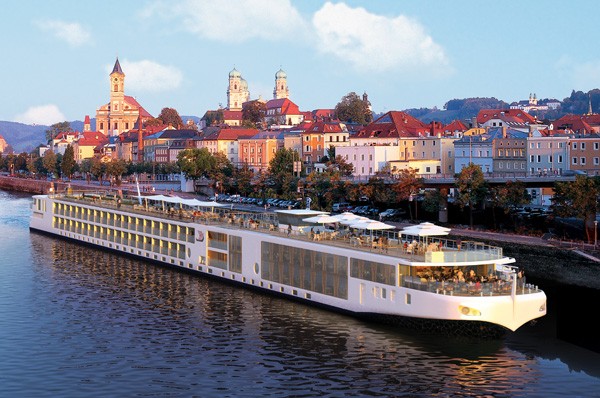
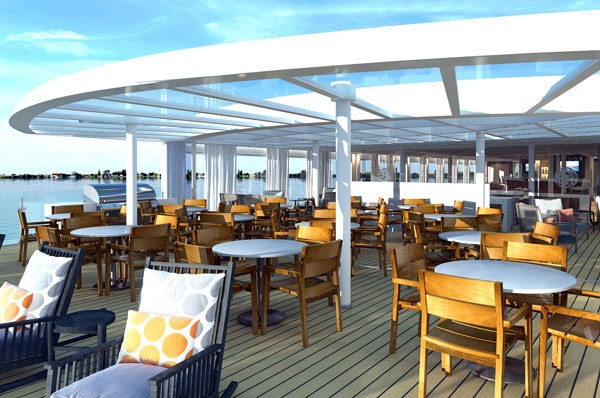
Aquavit
Terrace
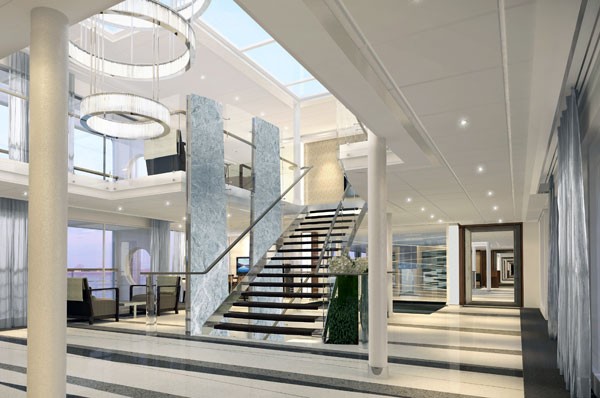
Main Lobby
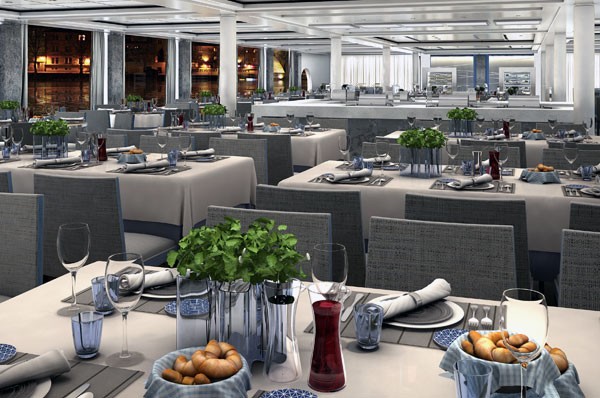
Main
Dining Room
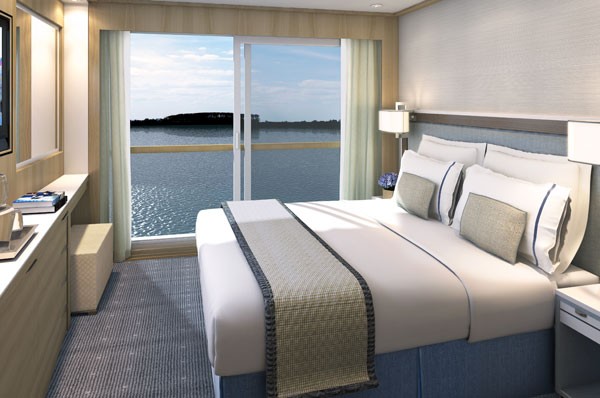
French
Balcony
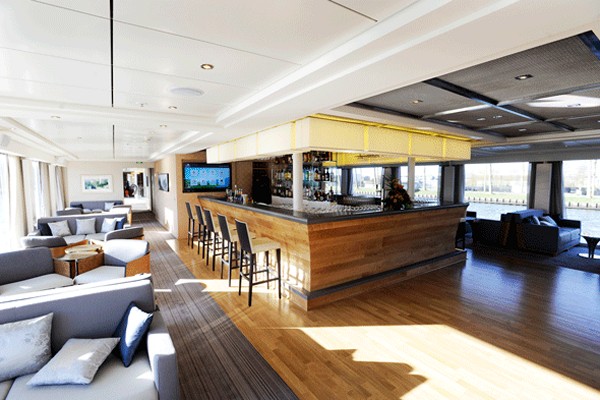
Dance Area
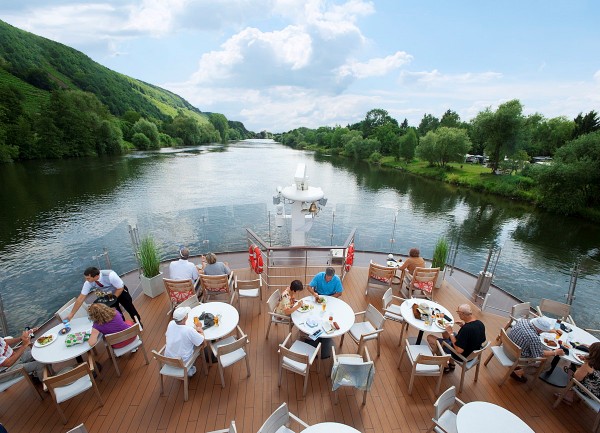
Outdoor
Dining Area |
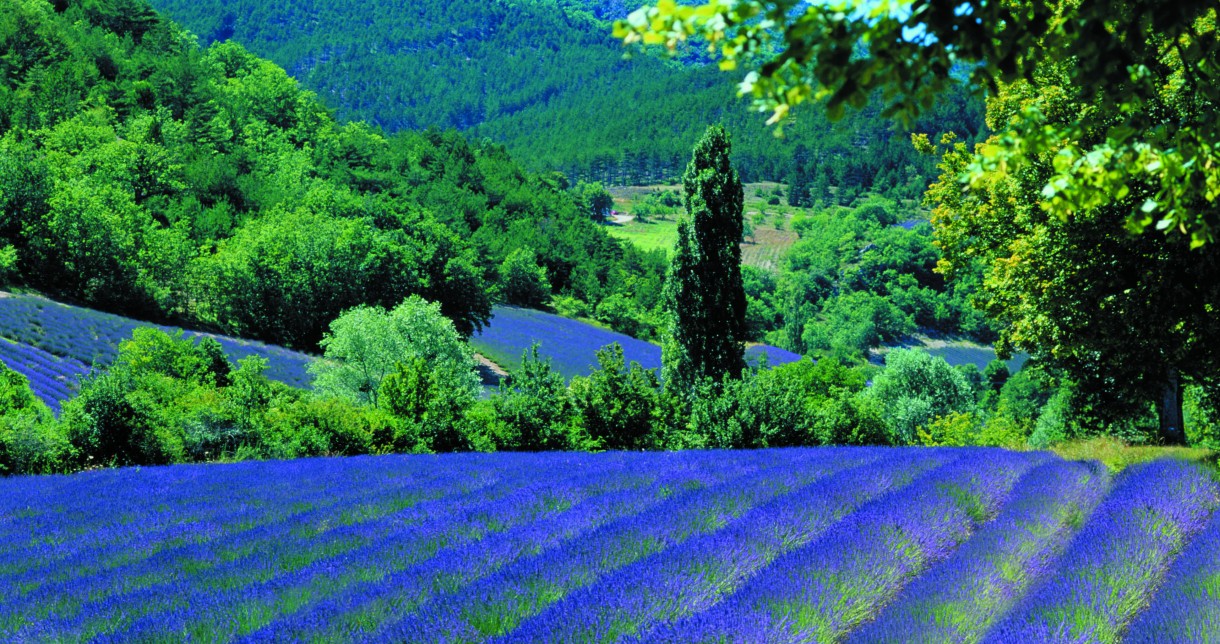
|
The River
Cruise Experience
|
Written by Rick Archer
May 2013
When
Marla told me she was thinking about scheduling our first-ever river cruise,
I thought she was reading my mind. I had recently
caught myself drooling with envy every time the Viking River Cruise
ad flashed on the TV screen.
I laughed when Marla admitted that ad had the
exact same effect on her.
With our first-ever River
Cruise scheduled to take place one year from now, I was curious to
learn about some of the differences between an ocean cruise and a
river cruise.
So I asked a friend who had
been on a river cruise before to explain the difference.
|
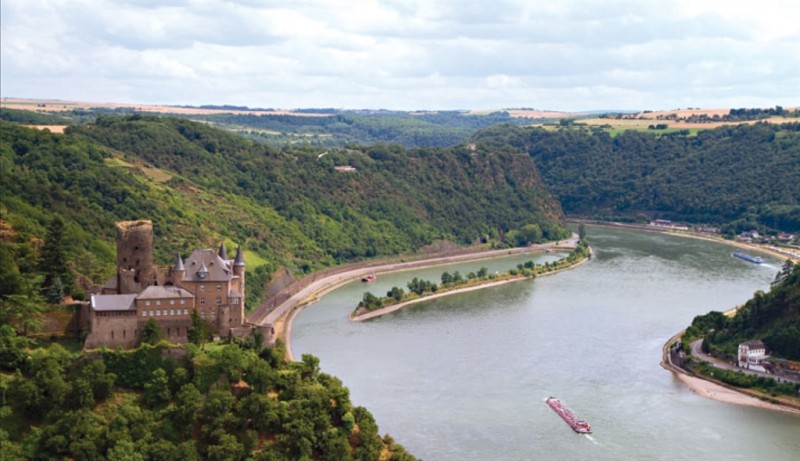 |
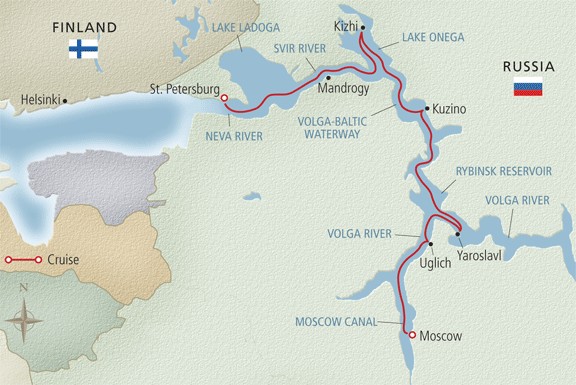
Russell's 2012
River Cruise to Russia
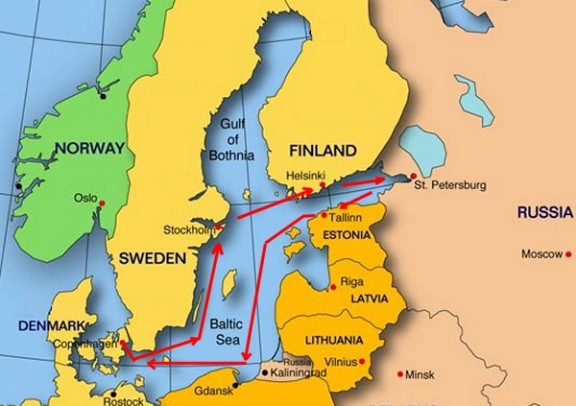
Rick's 2012 Ocean
Cruise to Russia |
The Tale of Two Maps
By
chance, my friend Russell Orr had visited Russia last year about the same
time that Marla and I took our
Russia 2012
Cruise.
Naturally every time I saw
Russell, I would
ask him about the river cruise he took to
Russia.
Truth be told, as we compared notes, I found myself having a hard
time controlling my envy.
Please
don't misunderstand. My cruise to Russia was an unforgettable
highlight tour. In particular, I loved Stockholm and I loved
Tallinn. It was a great trip.
But
what I really wanted to do was to see more of St. Petersburg. I
spent nine hours in St. Petersburg. Russell spent three days.
I spent no time in Moscow. Russell spent three days.
Need I
say more??
An
ocean cruise gives you a wonderful look at the Big Picture, but will
frustrate you if there's a place you prefer to concentrate on.
A river cruise allows a person the luxury to focus directly on a
region.
One
evening I asked Russell to talk about what it is like to be on one
of the long boats they use on the river. Russell's eyes lit
up like Christmas candles. I could see
the delight in his big smile.
Russell started his reply
by saying I could not even begin to imagine the joy of his trip.
Russell grinned as a memory flashed
across his mind and then he began to tell me a
story. I may get the details a little mixed up,
but here is the gist of it.
Russell said his favorite
moment was
a particular "enchanted evening"
spent dancing with his beautiful lady
friend Pat.
Russell explained that the ship
had hired some Russian college students
during the summer to help run the show.
This was a great way for the young people to pay
for their education.
Russell said he had no idea "Russians" could be so friendly.
He
concluded that unlike the dour old-timers who still bear the
scars of the Communist era, the young actually know how to laugh and
smile.
|
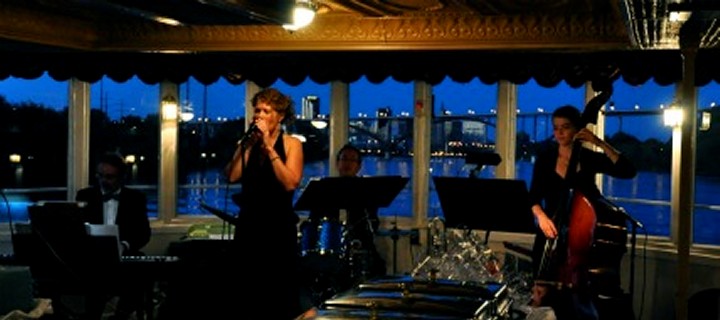 |
Russell said among the
enthusiastic college kids were two musicians who played every
instrument under the sun.
Each night the
duo would play their music
and each night Russell and Pat would get out and dance under the
stars. Russell added they were the only guests who actually danced.
Apparently there was a closed
circuit camera that was focused on the music area. This camera sent
a feed to every cabin so people could listen to the music in their
rooms if they wanted to.
|
Russell explained that the dance floor was situated right in front
of the musicians and their array of instruments. Apparently the camera's eye included
both the musicians and the dance floor as well.
One night as
Russell and Pat danced the night away, the camera caught their every
move… and neither of them had any idea they were putting on an
90 minute show for the
entire ship!
The next morning one
guest after another came by to thank them for providing such
wonderful entertainment! In fact, one guest
asked Russell if they were planning to do it again. They were
the hit of the cruise!
I am sure Russell and Pat were a little
embarrassed that their special moment was captured on
camera, but deep down I think they were tickled by the praise as
well. I asked Russell if the camera caught any smooching. He
grinned and blushed a little, then politely declined to answer.
I probably have no
business sharing such an intimate story, but it is so cute that I
could not help myself. 'Tis better to
share and ask forgiveness later!!
I have no doubt that
Russell and Pat made every guest on that ship wish they could dance
too. I always tell men they should learn the fine art of romantic
dancing. Chances like this river cruise come along too rarely in
life as it is. Why not make the moment perfect?
I
always say that Slow Dance and Romance go hand in hand.
Indeed, something pretty special happened on that river cruise. When
the couple returned to Houston, Russell asked her to marry him...
and Pat said yes.
|
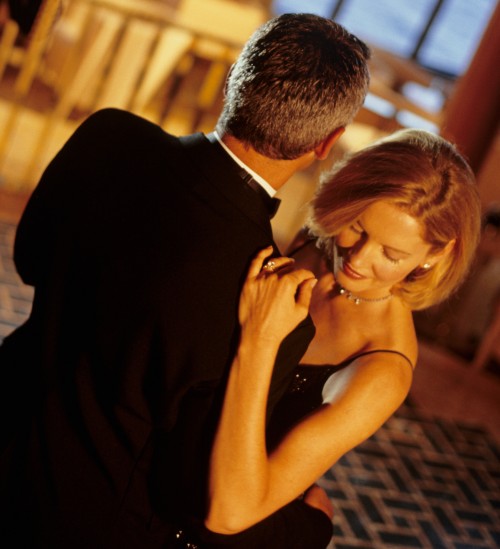 |
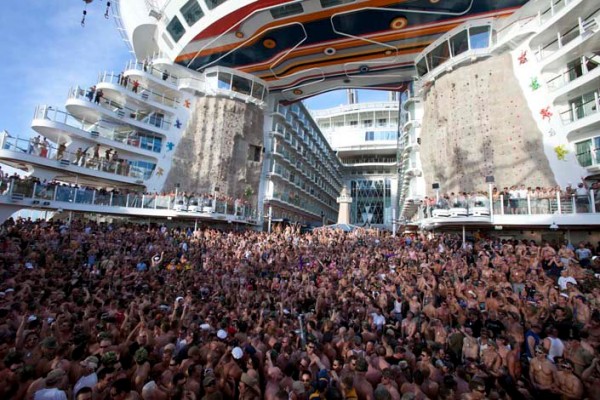
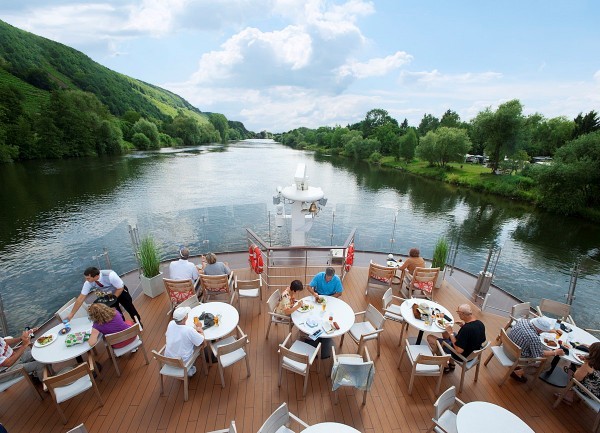 |
A Very Select Group
From what I gather, the
river cruise adventure has many features that separate it from our
ocean experience. Just for starters, you are swapping
a massive ship
that carries anywhere from 3,000
to 6,000 passengers for a
slender ship that
carries a maximum of 190 very privileged
guests.
If you
are comfortable with crowds and don't mind waiting in lines, then
trips on monster ships such as the one pictured might be fun.
However, I will confess that at my age I feel more at ease with the
intimate setting.
I
like a small group. I get to see these
same people every day and I
have an entire week to get to know them. I might
even make a friend for life with an opportunity like this.
They say a cruise ship is
like a floating hotel. I say a river boat is closer to a floating
inn. Or maybe a very large yacht!
Another major difference between a river cruise and an ocean cruise
is the view.
On an
ocean cruise, you spend countless hours staring out at the sea.
For people stuck in the city for most of their lives, this is a
welcome sight. That said, seeing the same vista day in and day
out grows old very quickly. You soon find yourself glancing at
the water from time to time, but that's about it.
On a
river cruise, there is actually something to look at it.
You will
literally float
through the most beautiful countryside imaginable.
You will gasp at one precious sight after another.
Not
only can you dine out on deck, every cabin has a river
view. Be it forests and vineyards,
farms and chateaus,
there will be always be something new to capture your fascination.
No matter where you are on the long ship, you can just sit
there watching the world go by. Sip your
wine and enjoy one of the happiest moments of your life as
rolling hills and
the ever-present green countryside
moves
across your eyes in an endless tableau
of pastoral beauty.
|
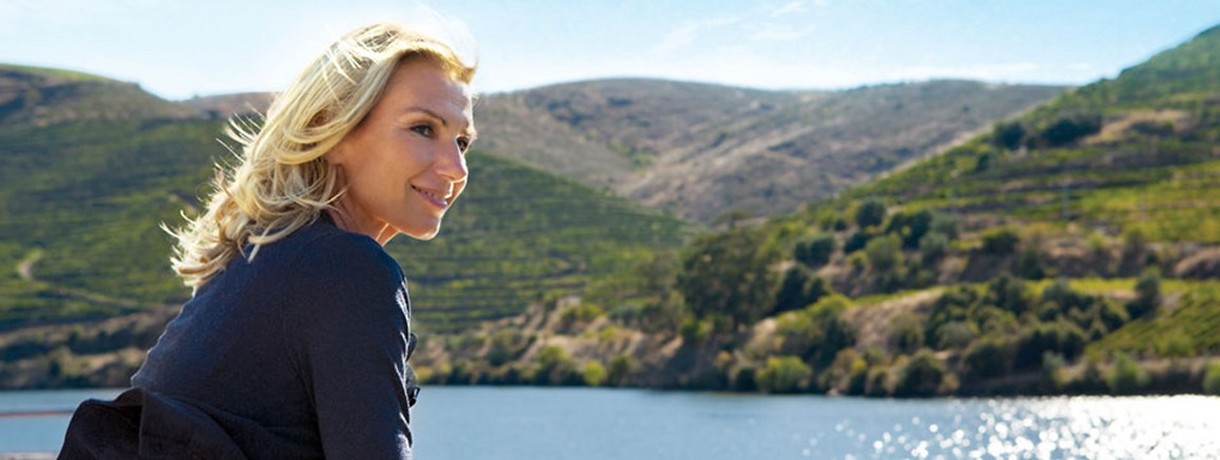 |
Tender Mercies
There are no days at sea
when you sail down the river. Each day
brings you to one
quaint town or precious little village after another.
Each day takes you to a new adventure.
The
Rhône River has served as the "Mississippi" of France for centuries.
Local farmers have used the river to transport their goods to market
for centuries. Furthermore, ships from all the Mediterranean
countries have long used its waters to trade with Northern France.
Consequently, there are existing docks at every town where our
longboat can pull up and drop you off instantly.
At each stop the
boat will dock
right in the center of the town.
It takes all of one minute to get
on or off the ship. You can stroll through the town in the morning,
come back to the ship for lunch, then head back out and explore some
more. You come and go as
you please. This is the right way to see the world!
|
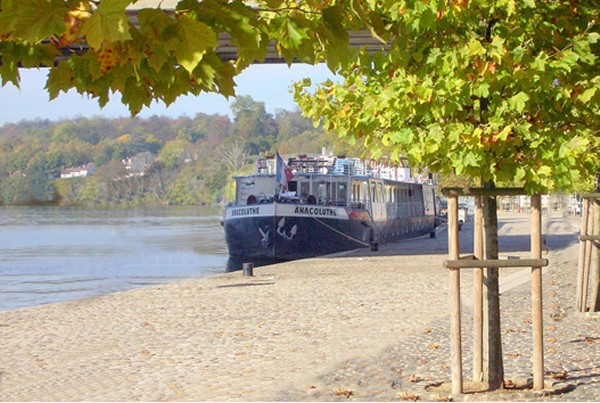 |
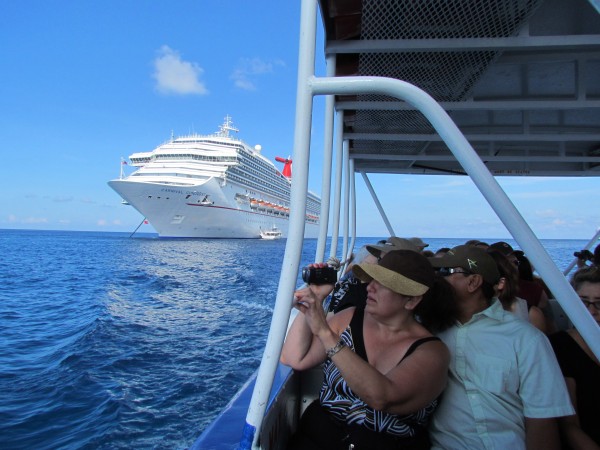 |
Now compare that to the
tedious "tendering" process common to the large cruise ships.
On every
other trip I have taken, there is at least
one port that requires a smaller boat known as a "tender" to ferry
you onshore.
If you are given seven
hours at a port, two of those hours are completely wasted.
For
example, we recently used a tender in Belize on our Mariner 2013
trip. Our ship was parked over a mile off shore. I
estimate we burned at least an hour and a half traveling back and
forth.
We
always use a tender at Cayman. The huge lines mean at least
one hour in each direction.
Tendering means you get
to wait in line for half an hour to get on the boat. Then you waste
another half hour getting there to the island.
Then you have to turn around
and do it again in the evening.
There is no time wasted
on a river cruise. You don't spend half your trip at sea
and you
don't spend half your day on a tender.
In fact, if you wish, on a
river cruise you can be busier with sightseeing than practically any
trip you have ever taken.
|
|
|
|
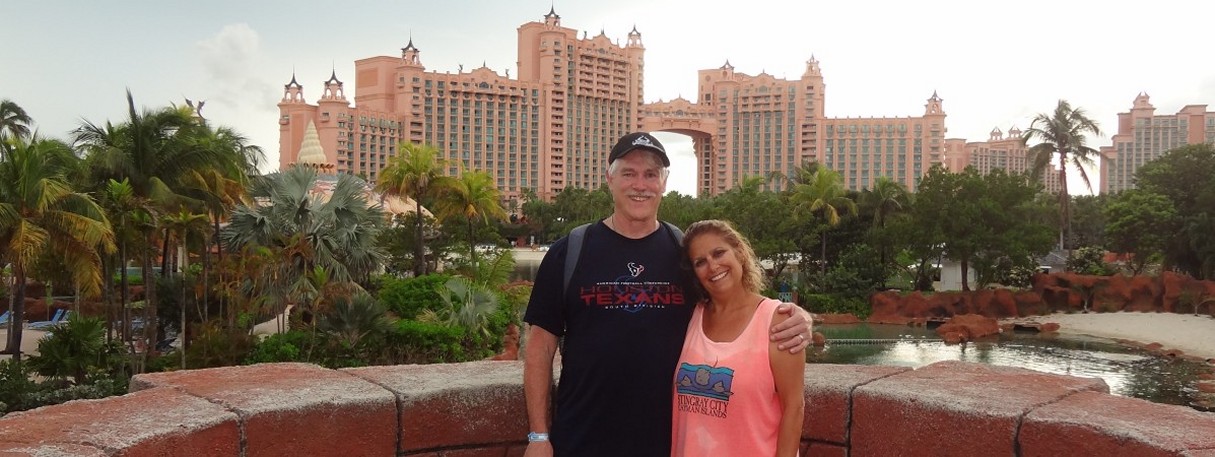 |
The Atlantis
Awakening
No one is going to deny a
river cruise is expensive. As with any premium adventure, you have
to pay a price for the privilege of having a
truly wonderful experience.
In
2010, I visited the water park at Atlantis in the Bahamas for the
first time. On that visit, I
made a very unusual discovery.
Prior
to the trip, I blanched when Marla said tickets were $130 for a
day's visit. That would $260 for the two of us. "No
way", I said. But Marla showed me the pictures and persuaded
me.
On the
night before our cruise ship stopped in Nassau, I asked several of
the passengers if they were going to visit Atlantis. Every
person said the same thing. "Nah, it's way too expensive."
I
estimate only a dozen people out of 200 guests went there that day.
That's a shame because
Marla and I ended having the time of our lives.
The rides were incredible and there were hardly any lines. The
place was not crowded at all.
Our
favorite ride was the Lazy River. We had so much fun, we
stayed in those tubes for nearly three hours. Marla and I were
alone 80% of the time. It was an incredible experience to have
this remarkable playground all to ourselves.
That's
when it dawned on me. You get what you pay for. Pay low
prices, get big crowds. Pay big prices, have more fun.
On a river cruise, you save time, you meet truly interesting people,
and you see the world in perhaps the grandest way possible.
St. Augustine famously
said, "The world is a book, and those who do not travel read only
one page."
During
the years I ran my dance studio, I completely ignored the rest of
the world. Then Marla introduced me to travel. On each
trip I learned a new reason why people value travel so much.
The
first time I saw Rome, suddenly the history of the Roman Empire came
alive. When I saw Turkey, I began to think of Noah's Ark and
the possibility the
Black Sea
and the melting waters of the Ice Age could explain the myth of the
great flood.
When I visited Scotland, I developed a superior
understanding of the struggle between the Scots and the English.
When I went on the Titanic Cruise, I got so deeply in touch with the
tragedy that I felt like I practically knew the people who died.
When I
saw Barcelona, I discovered just how beautiful a city can be.
When I saw the Panama Canal, I was incredulous at the magnificence
of the engineering accomplishment. Travel helps me learn so
much about things I never knew before.
Another quote about travel I like is from Mark Twain. "Travel
is fatal to prejudice, bigotry and narrow mindedness... Travel helps
us discover we are a family after all."
When I
visit other lands, I start to realize exactly what Twain meant.
Race, religion, ethnicity all begin to mean less. People all
want the same thing - peace, safety, health, prosperity. The
world becomes a much smaller place when you travel.
I am
63 as I write this story. If you are anywhere near my age,
then you understand that time grows more precious every day.
People my age don't have a lot of time to waste any more.
Why
waste time if you can afford not to??
Based on our Puritan
ethic, few of us allow ourselves the risk of high-priced luxury.
We have spent our entire lives denying ourselves the finer things in
life so we will have money at the end. But the cruelty of
aging is that despite our frugal ways, we have only a small ten year
window where we still have the health to see the world. Once our
health goes, travel will never be the same again.
Life
is for living, not passively sitting at home waiting for the end.
Some of you
might agree we have reached the point in
life where we have earned the right to pamper ourselves.
As they
say, there are no pockets in shrouds. You can't take it with
you.
|
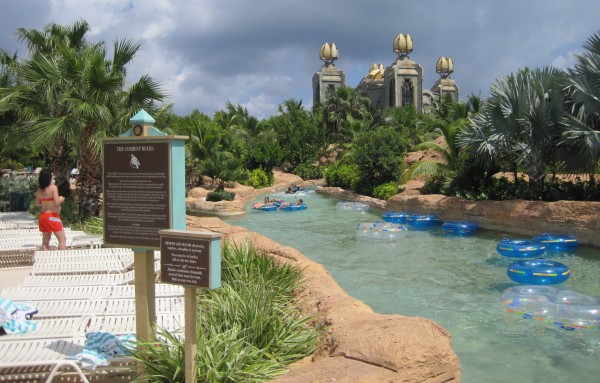
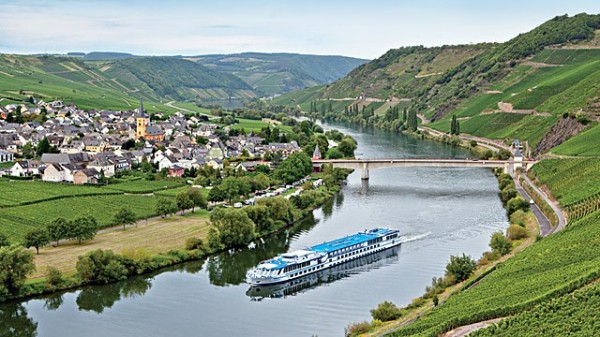
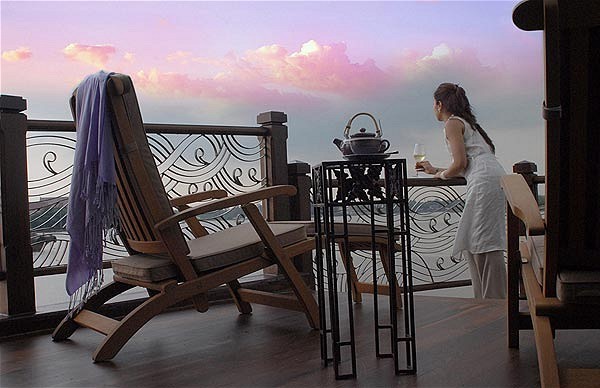
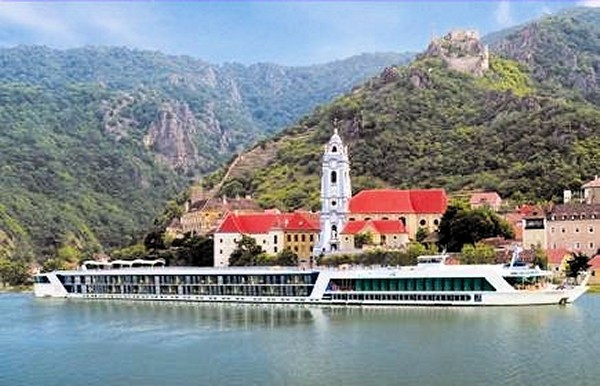 |
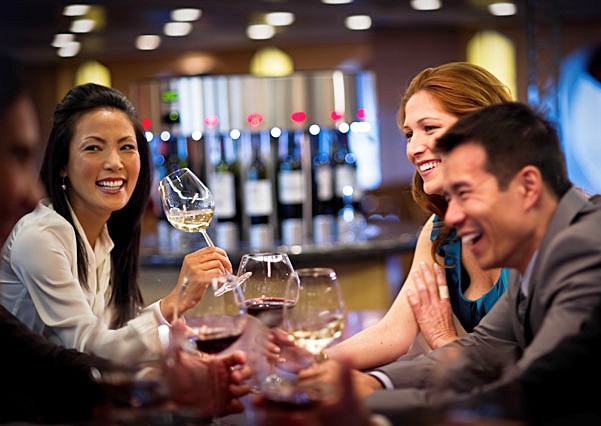 |
Complimentary Wine
While
a river cruise is undeniably expensive, there are
savings in places we aren't accustomed to. There are
complimentary features that will certainly be appreciated.
For
example, there is complimentary wine served at every meal except
breakfast. You can have as many glasses of
wine as you wish (if you prefer
beer, soda or water, that is served free as well).
When Marla and I sailed
aboard the Azamara Journey for our Titanic cruise, the wine was
served throughout each meal.
Barriers fell quickly
thanks to the magic of the wine. Every night at dinner, the dining
room was animated with laughter and talk.
One of
my favorite moments on that trip came when my brilliant
friend Bob and I talked deep into the night. Bob
was an expert on the Titanic. Thanks to our
wine-loosened tongues, Bob opened up. He told me
stories and angles I never knew before. I learned more about the Titanic that night than I ever
thought possible. Bob and I became friends for
life. I could see Bob again and restart the conversation in a
flash. There is something about wine that
helps get the party started.
|
| |
A Cultural Experience
|
 |
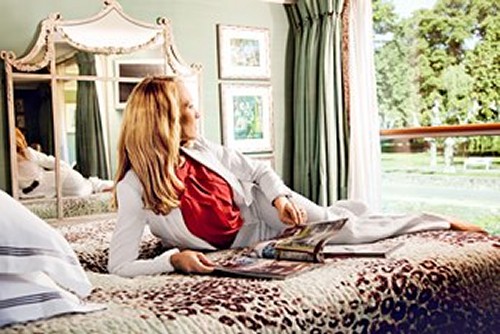 |
Complimentary Excursions
A river cruise differs
from an ocean cruise in that it gives you a fighting chance to
really explore.
Don't get me wrong… I
like ocean cruises. But if there is one downside, it is the
superficial treatment that each port receives. A river cruise
differs from an ocean cruise in that it gives you
enough time
to walk around and learn.
Like my trip to
Paris on
our Oslo 2010 cruise, there simply wasn't enough time to even begin
to see the city. We had five hours total to explore. By the time
we reached the Louvre, we didn't have enough time left to go in.
We just stared at the windows of the most famous museum in the world
as I screamed with anguish. This isn't right!! And then it was
time to head back to the bus.
|
|
A
river cruise wishes to educate its passengers about the region of
the trip. Therefore,
in addition to
free lectures
on board, each day there are several small-group
sightseeing excursions at EVERY port. You don't pay a dime.
The ship wants you to participate in the learning experience, so
these visits are complimentary.
More than likely, you
will meet a cheerful, outgoing guide who
will escort you through
each new town. In addition to being quite knowledgeable
about the region, the guide will learn your name,
where you are from and maybe even
your favorite type of wine.
Your
guide will quickly
assess your physical status and be able to give
advice on what
trips you can handle and what you might do if you need an
alternative.
Best of all,
our guide will help immerse
us deeply into the culture of the region.
France
is steeped in all sorts of fascinating ancient history. At different times
the Franks, the Gauls, the Greeks,
the Romans, the Vandals, the Goths, and the Moors have fought countless battles for control of this
precious
farmland.
The
area we will visit was featured in Julius Caesar's Gallia, a
book where he told the story of his conquest of Gaul in 58 BC.
You will be amused that in my 8th Grade Latin class, I actually
translated some passages from Caesar's Gallia. Believe it or not,
I still have the book!
"Gallia est provincia magna in Europa.
Gallia est patria agricolarum. Puellae silvas Galliae
amant."
That
was from Chapter One. I bet you can translate it...
"Gaul is a large province in Europe.
Gaul is farmland. Gaul has beautiful trees."
Many
of Caesar's battles were fought right along the Rhône River.
For that matter, his greatest victory, the Battle of Alesia,
was fought just a few miles north of Chalon where our trip ends.
|
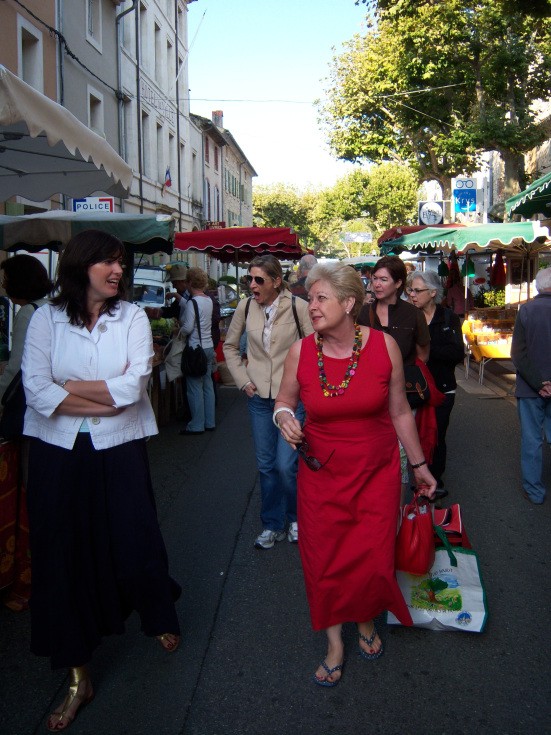 |
Avignon, one of our stops, was once the most powerful city in
Southern France. Avignon owes much of its importance to
Caesar. After Caesar conquered it, he made the town his
favorite outpost. Avignon was important because the Rhône was
the route taken by Mediterranean sailors wishing to trade with
Northern Europe. Control of the Rhône was vital to the
conquest of the entire region.
|
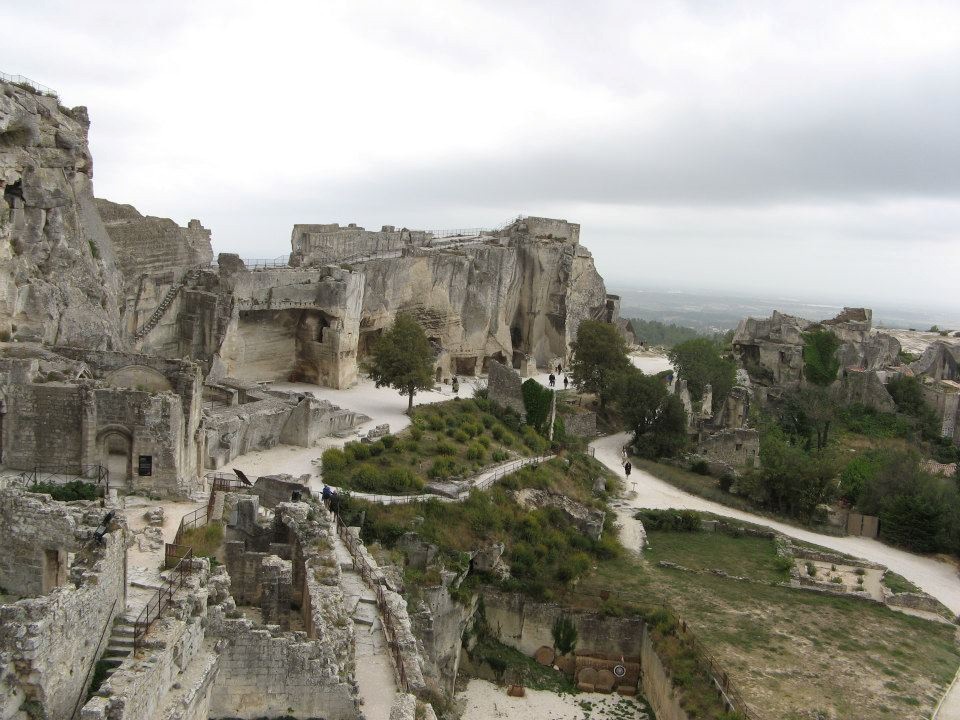 |
After
Caesar vanquished this city, he ordered an elaborate defense system
be built.
Why bother winning it if you aren't going to keep
it??
Today Avignon features some of the best preserved
ramparts (defensive walls) in France.
Here is a picture of the
Roman ruins in Avignon, France. These are some of the walls built to
defend the city.
We will get two chances
to visit these Roman ruins.
We will have the entire
afternoon of our first day to explore Avignon.
Then on Day Three of our
trip, we will visit Avignon again. On one of these days, we
will surely visit this amazing site.
|
Avignon has much more to
offer. For example, Avignon is called "The City of Popes".
Indeed, there is an amazing castle known as the
"Pope's Palace".
Most of us assume that
Italy has always had the most influence with the Catholic Church.
Not so. At one point, the French held sway. In 1305, a
deadlocked conclave finally elected Clement V, a Frenchman, as Pope.
Clement preferred to
remain in France, so he declined to move to Rome. In 1309 Clement
moved his court to the papal enclave at Avignon. It would remain
here for the next 67 years. This absence from Rome is sometimes
referred to as the "Babylonian Captivity".
A total of seven popes
reigned at Avignon; all were French, and they each increasingly fell
under the influence of the French Crown.
Finally, in 1376, new
Pope Gregory XI abandoned Avignon and moved his court back to Rome.
The Avignon Papacy was over.
Besides the castle, there's the
mysterious "Bridge to Nowhere". The reason the
bridge remains
incomplete is pretty amusing.
Apparently over
centuries, erosion has damaged the bridge. At this point, the
remaining part of the bridge has been restored, but now it is too
low for a river boat to go under... so rather than raise the bridge, they found it easier
to leave the job undone.
Tourism is more valuable to the
city than have a complete bridge. So many people are amused by
the unfinished bridge that it has become the international symbol of
the city.
You didn't know any of
this, did you? Neither did I. Travel is a dynamic form
of education.
|
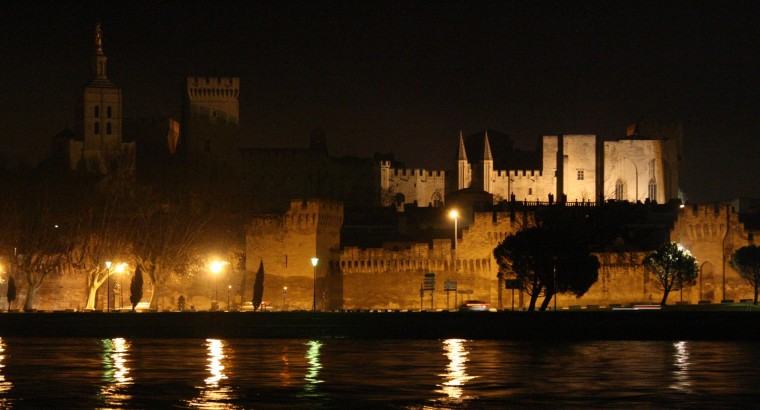
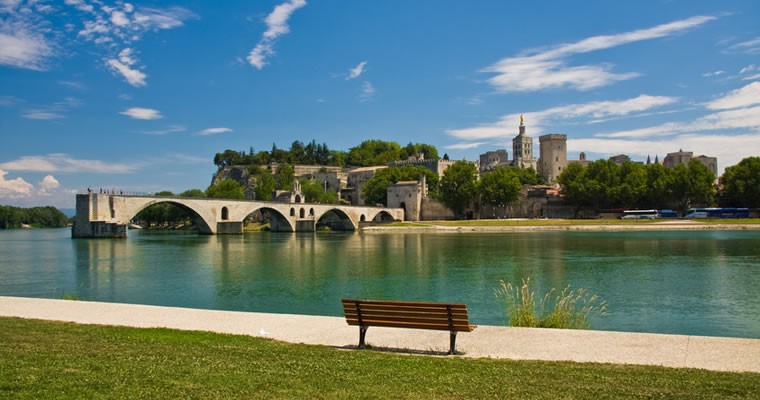 |
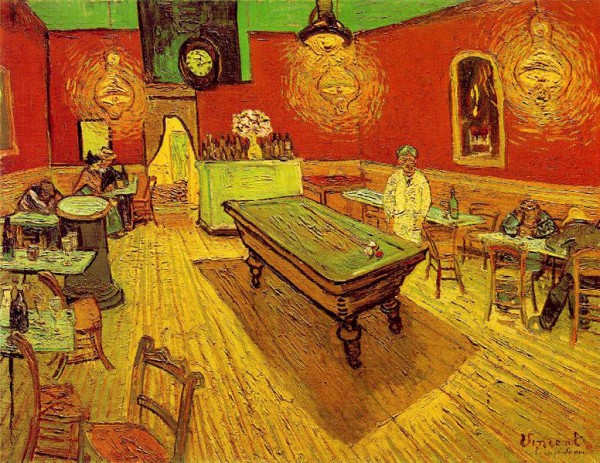 |
I have been on 27 cruise
trips so far. Only twice have I been on a trip that attempted to teach me something
about where I was going. Both trips occurred last year.
The first was our visit to the
Panama
Canal. The other experience
was the
sad
Titanic Memorial
cruise that sailed to the spot where the Titanic sank.
Other than those two
trips, there has never
been any attempt whatsoever to educate the
passengers on the history and the culture of the places we visit.
Why cut into valuable bingo time?
That will change
dramatically on this river cruise.
Our trip through southern France promises to
offer one history lesson after another. We have already
discussed Avignon.
What
about Arles??
Arles is a quaint village that became the home of
Vincent Van Gogh for about a year and a half towards the end of his
life (1888-1889).
A
deeply disturbed man, Van Gogh began a steady descent into madness
during his time here. And yet remarkably, Van Gogh was very
prolific in his artwork. During our visit to Arles, you
could easily learn more about Vincent Van Gogh than you ever
imagined... or maybe even wanted to know.
For example, you will discover this is the town
where he cut off his own ear.
|
| |
|
 |
|
France - A World Leader in Art, Science,
Fashion and Culture
|
France has long been
Europe's epicenter of art, science, philosophy,
fashion and culture.
This
trip is so different that you
will have the chance to actually meet the French people in a way
that allows for the exchange of ideas and politics.
You won't have a tour
guide that you see today for the only time in your life. You will
actually get to know your guide on a personal basis. If you ask the right
questions, you may learn about France and its people in a way that
will far transcend any documentary or book you might read.
There have been rumors
over the years of animosity between the French and the Americans.
We have heard about French rudeness and disdain for our
politics.
As a result, we make fun
of the French. For example, 'Q: Why don't they have fireworks at
Euro Disney? A: Because every time they shoot them off, the French
try to surrender.'
Yes, it's true that the
USA saved France in both World War I and World War II. Good for
us! But please do not forget that America might not even exist
were it not for France.
|
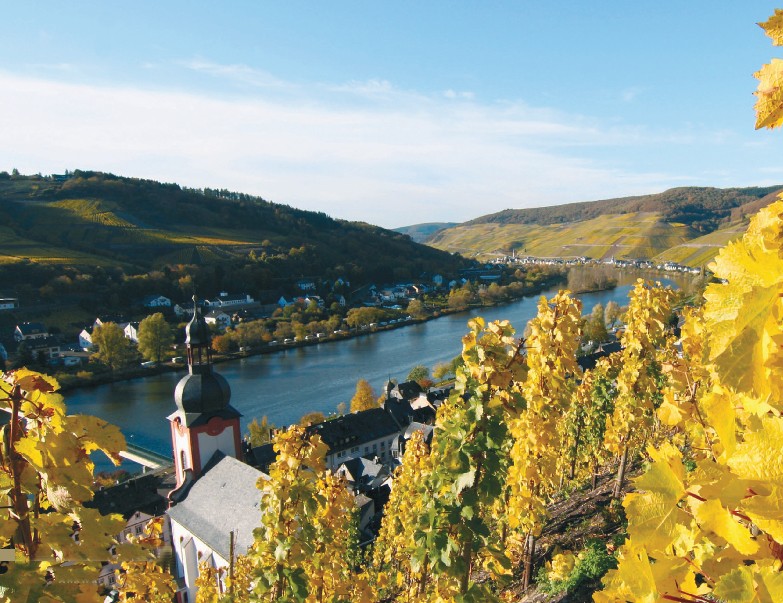 |
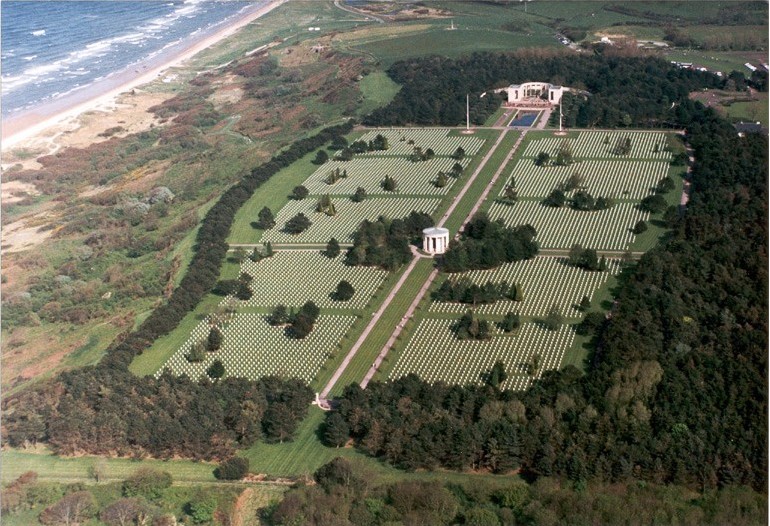 |
It was
France's intervention into the Revolutionary War that proved to be
the turning point. Without France, we might be the 50 Colonies
today and the Atlantic might still be known as "The Pond".
And I would like to add
that Omaha Beach of D-Day fame is practically hallowed ground to the
French. There is a sign at the national cemetery that says:
"This ground is
dedicated in perpetuity to the people of the United States of
America for the sacrifice its brave and noble fighting men gave to
our country."
There are 10,000 graves
at that cemetery. It is a very moving sight indeed.
I cannot even look at this picture without tears welling up. I
wish to add the French
consider it an honor and a sacred duty to guard and protect this
cherished property.
Furthermore,
every year French citizens in the Normandy area come out to
celebrate D-Day with American flags, parades and a huge outpouring
of gratitude. Americans are absolute heroes to these people.
|
To this day, there are people in
this area who witnessed the American bravery first-hand.
They watched in horror as young soldiers died
trying to liberate them. They wept as helpless soldiers were shot
down in their parachutes.
They peeked through their windows to see
brave men die in door to door fighting at St. Lo and Caen.
They even helped bury
the countless young men who died facing
deadly machine guns on the nearby beach
at Omaha.
|
There
is no 'French rudeness' in Normandy, only gratitude.
These people remember
what happened like it was yesterday. They saw people they had never
met before who sacrificed their lives to save them from Nazi
tyranny.
Their attitude is eternal:
We will never forget America.
This rumor about French
rudeness is a myth. Sure, if a tourist
behaves poorly, naturally they
can expect to be treated in kind. But that is the exception. In
this world of crazy senseless terrorism, France is thrilled to have
our friendship. France is one of America's truest allies.
I have visited France
twice. Wherever I have gone, Marla and I
have been treated with warmth and respect. All
I had to do
was wear a smile and I received
the kind of welcome accorded to a trusted friend
and neighbor.
Both times I found myself utterly charmed by
the beauty
and culture. I welcome the opportunity to learn more about this
amazing country.
|
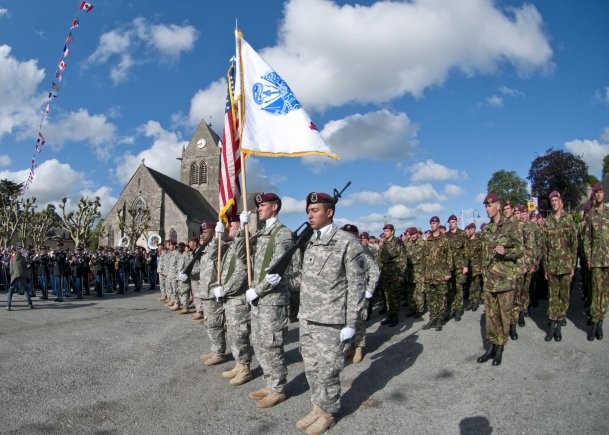 |
| |
|
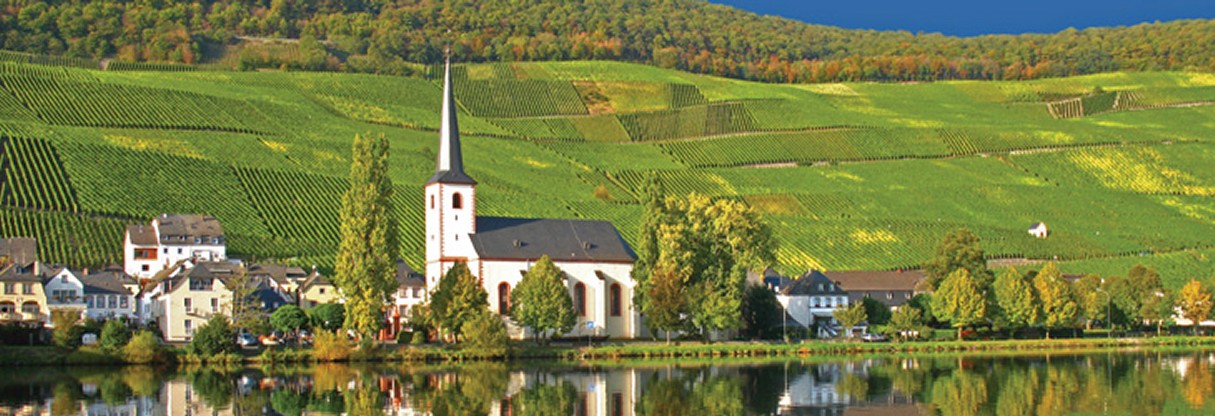 |
Parting Thoughts
There are other pleasant
surprises about this trip that might not have
occurred to you.
For example, there is no
such thing as "seasickness" on a long boat. The rivers are wide and
smooth. There is no such thing as waves and rapids. The ship
simply glides through the calm waters. If anything, the sailing has
less vibration than your average bus ride.
People
might read my story and conclude that I am knocking ocean cruises. There
is an old saying, "Don't bite the hand that feeds you".
I am not disrespecting ocean cruises. As Marla constantly points out, an ocean
cruise is an extremely safe and cost-effective way to see the world.
There
are times when an ocean cruise makes complete sense. For
example, a cruise is the perfect way to see the islands of Hawaii.
Ordinarily, to see all the islands of Hawaii would require daily
transfers from island to island and new hotels every night.
There would be considered time wasted.
Since
a
cruise ship is basically a floating hotel, it is perfect for Hawaii.
Likewise for Alaska and the United Kingdom. Using the water is
a very efficient way to visit these areas.
On the
other hand, there are places that are inaccessible by sea that can
be reached by river. Europe is the perfect example.
To me,
a river cruise is simply a more surgical form of an ocean cruise. For example, a
cruise ship might be able to go through the Panama Canal, but only a
longboat can sail the Rhine, the Danube and the Volga - and the
Rhone and the Seine of France.
Suddenly areas in Germany, Switzerland, Austria, and Hungary become
accessible to one of the most comfortable forms of transportation
imaginable. Who ever thought a cruise trip could take you to
the Alps? Castles and mountains and forests are magically
placed right at your fingertips.
A river cruise allows you
far more time to
explore a city or a town than you can ever
imagine. You have all morning and
all afternoon to tour the place. Your day can begin as
early as 6 am if you actually have the strength to get up
at that hour.
Here's
something else you may not have considered. Have you ever
thought of using a bike to expand your reach? Marla and I have
tried bicycles in several places. For example, we have used
bikes to explore Key West and Martha's Vineyard. Usually the
drawback is time. We wanted to use bikes in Maine's Acadia
National Park, but the stupid ship wasted so much of our time with
tendering that we had to scrap our plans.
Not so
on a river cruise. As we discovered in Key West, a bicycle is the
perfect way to explore a small town. Since the boat drops you
into the center of town, you can rent a bicycle in the plaza
and off you go. Imagine all the ground
you will cover. You can ride through
the streets of each village as far as your body will let you. Then when you get hungry,
head back to town,
drop the bike off right in front of the ship and hop back onboard.
How could that possibly be easier?
|
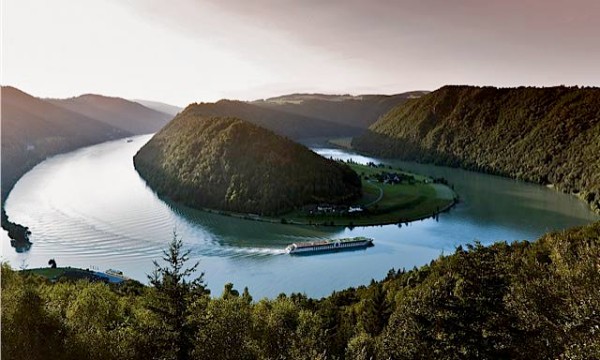
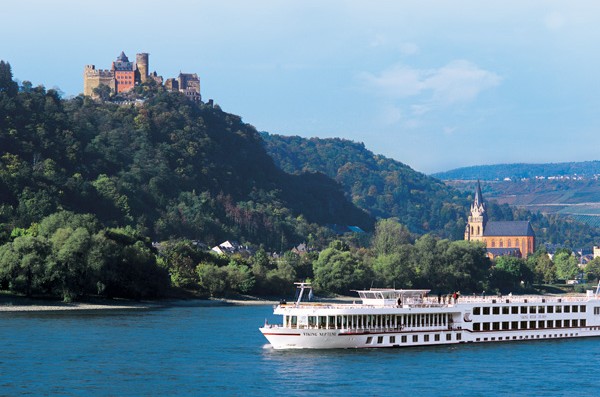
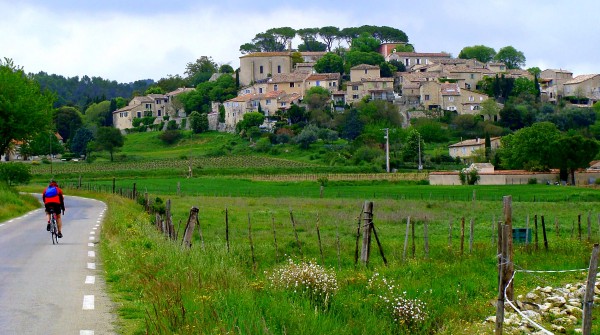 |
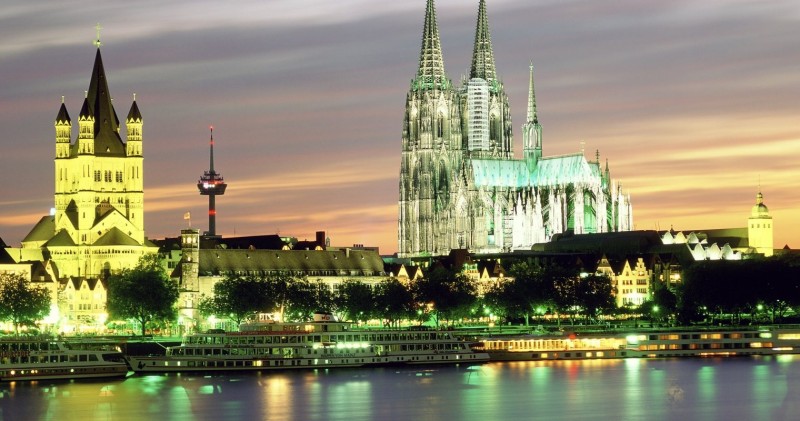 |
Better yet, you have the
evening too!
I suppose it does get
dark once in a while. Actually, now that I think of it, maybe even
once a day.
On an
ocean cruise, I don't even think about a port at night.
On a cruise ship,
typically you need to get back on board at 4 pm so the ship can sail
hundreds of miles to the next port.
Or perhaps we get back on
board early so the gambling casinos can begin to operate again.
Many times I have wished I could have dinner in town
at night and go to a nightclub
afterwards.
|
A good example would
have been St. Petersburg on our 2012 cruise to Russia.
My word, here we were six thousand miles from
home. How cool would it be to have dinner with Marla and our
friends in this amazing historic city? Let's see what Russian food
tastes like and see what Russian nightlife looks like.
However that never happened. At 4 pm we were
hurriedly whisked back on board the cruise ship. Poof!
It was here and now it is gone. One
brief taste of the city and we had to leave.
Wouldn't it have been nice to see a performance of the Russian
Ballet? On a river cruise, that's something you can actually
do.
Perhaps
in France we might take in a show
somewhere in town. Why not see the fabulous
French Can Can in person??
A river cruise is totally different. There is
no gambling, so the ship has no reason to rush you back on board.
Furthermore, the ship typically sails in the wee hours of the morning. After
all, the next stop is just down the river. The entire length of the
trip is only about 200 miles from start to finish. It is 124 miles
from Avignon to Lyon. It is 70 miles from Lyon to Chalon.
|
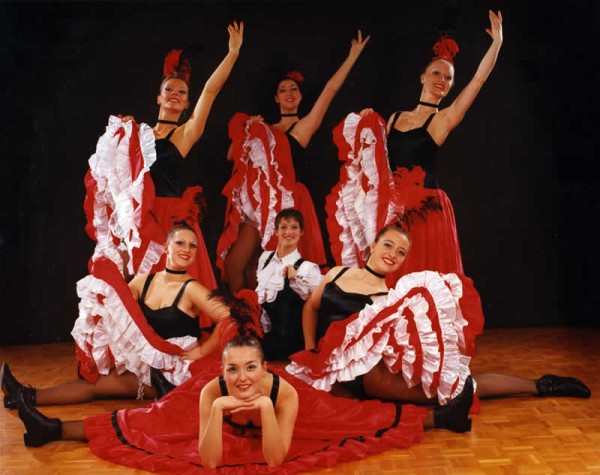 |
That averages out to
about 30 miles per night. Each night while we sleep, the staff
simply gets out their oars.
They sing 'row, row, row your boat
gently down the stream' in French as they merrily paddle away. Be careful not
to join in the singing… they might hand you a paddle.
The consequence of these
short distances is startling. Most evenings, the long ship stays
docked right at the pier so you can get off the ship at night and
have yet another adventure.
How about sipping some wine at a
sidewalk café with friends?
Imagine sitting there
under the stars with a breeze during a blissful April evening.
Maybe they will play French music while we sit. Will be the sad "La
Vie En Rose" sung by Edith Piaf?
Or will it be "La Marsellaise",
the French national song made famous in Casablanca
when the French loyalists defied the Nazi occupiers by singing over
the voices of the Germans?
|
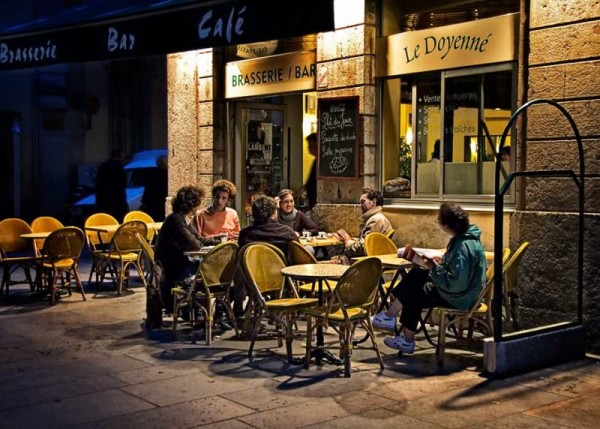 |
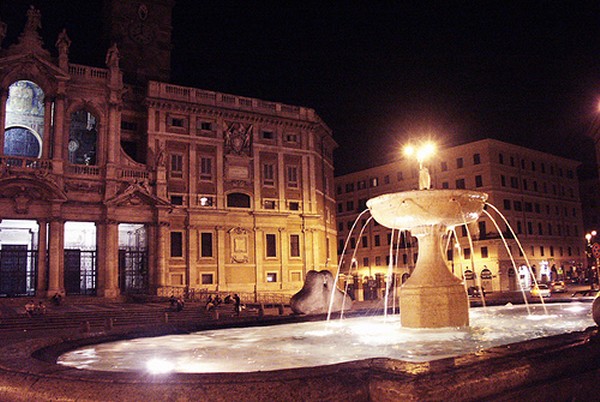 |
Or perhaps you might just spend your
evening strolling around ancient Roman
fountain under the moonlight in the town plaza.
It doesn't get any better than this.
Even the caliber of the
crew is different. As Russell explained to me, there is a warmth
and savoir faire to the college educated crew that transcends what
you might be used to on an ocean cruise.
At the max, the ship holds
190 guests. With a staff of 45 people, that creates a startling
ratio of one staff person to four guests. As a result, almost all
the crew learn your name, not just the waiter and the room
attendant. For that matter, maybe you will learn
some of their names too!
There are
many
advantages to this sort of intimacy. Each waiter and each bar
person will know what beverage you
desire before your lips
even move. All you have to do is whistle. Or use sign language if
you are too exhausted by all the fun to speak. I recommend
pointing, the Universal language.
|
If you don't want to go
into town, there is entertainment on board every evening.
Yes,
there is a dance floor. No, it isn't large, so yes, you better
brush up on your small floor ballroom dancing. I
definitely suggest you take a
refresher course on slow dancing. Incidentally, I happen to
know someone who is an expert at teaching small floor dancing in case you
need a few tips.
There is another
difference that might completely take you off guard. For example, I
was startled when Marla said there is no "Formal Night". Huh? I
didn't believe her, so I asked again. Marla shook her head with
confidence. She was sure of what she was talking about. No Formal
Night! What part of "NO" don't you get, Rick?
Marla said that on
a river cruise, comfort rules over style. The ship
deliberately cultivates a relaxed, resort-casual onboard atmosphere
- leave the formal wear at home.
I find that very
curious. If there is any place on earth where people collect who
can probably afford to look prosperous, I would guess it is on board
one of these long ships. And yet they de-emphasize the chance to
show off. Very interesting.
I suppose you can always
cheat if you want to. If you want to look really good, go for it.
They probably won't tell you to go back to your room and wear
something less flattering.
That said, be careful.
Don't overdo it. It's like a nudist colony… you're either in or
you're out. If I ain't looking good, then you better not be looking
good either. If anyone makes me look bad by over-dressing, I
promise to expose your fashion cruelty to the world through bad
photographs and snide comments.
Trust me, after I get through
doctoring your photo, you won't be smiling. Plus I will make you
look fat. That's a promise. Think Jabba the Pizza Hut.
|
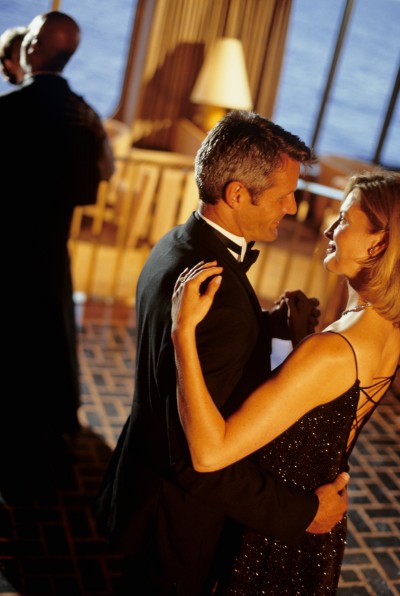 |
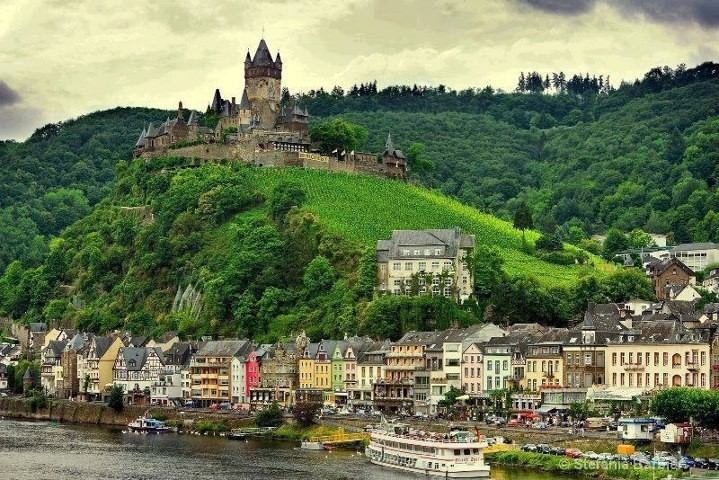 |
Speaking of pictures,
another thing you might find unusual is that no photographers will
interrupt your meal. No more quick gulps of food so you can force
the fake smile.
Another thing you will
surely miss are dancing waiters and loudspeaker announcements at
dinner. This absence worries me a great deal. Gosh, what we will
do? Without constant interruptions, we could be forced to develop
the long lost skills of witty dinnertime repartee.
How foreign is that? I
might have to practice ahead of time.
Speaking of the lost art
of communication, this trip promises to give people an
extended chance to get to get acquainted
on a much deeper level.
While
there is something to be said for the hot tub experience, I don't
think "deep conversation" is one of them. But if you are wandering
side by side through the streets of Lyon at night, you might
actually open up a little and bare your soul.
|
While we were on our
recent Mariner 2013 cruise, at dinner someone asked Marla what was
her favorite cruise. Her answer surprised me. She said, "Our river
cruise in 2014."
I immediately chided
her. "Marla, you can't pick a trip you have
never been on as
your favorite."
Marla responded in
typical Marla fashion, "Don't tell me what to think. This trip is
something I have dreamed about for a long time. I love everything
there is about this trip. If I say it is my favorite, then just
take what I say and accept it."
At this juncture, Marla
has already sold fifteen cabins
and has several inquiries to follow up on.
That is an amazing total when one realizes that Marla's group
promises to be somewhere between 16% to 25% of the entire passenger
list.
I say
this impressive number is a validation of Marla's work. This
is an expensive trip, no doubt. Therefore to have so many
people show this kind of confidence is quite an honor.
|
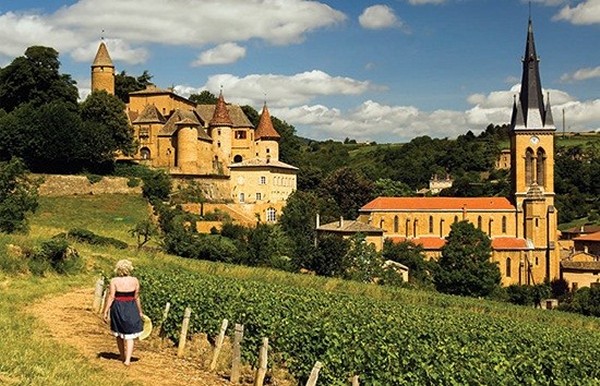 |
The
one thing I can promise is that
we will be a family.
You can count on that.
Marla and I had this
exact experience on the
2012 trip to Russia.
We
all shared so much warmth and laughter traveling together.
|
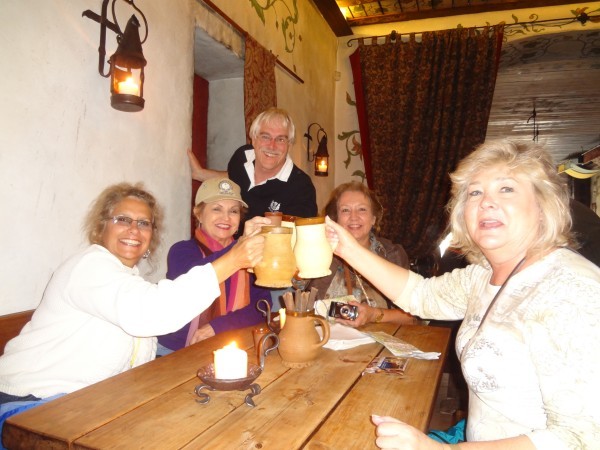 |
In Denmark, we stayed at the same hotel. It
was there that the girls surrounded Marla with reassurance during my
bizarre passport dilemma (yes, I actually lost my
passport!)
We
shared meals and went strolling through the magical Tivoli Gardens
together. In Finland, we shared lunch in the cellar of an intimate
countryside inn. In St. Petersburg, we drank vodka together in a
huge Russian dining hall. In Estonia, we drank
beer together
in a dark candlelit German biergarten.
We grew close. We had an
entire journey filled with special moments like these. We banded
together and became best friends in foreign lands.
Marla and I agreed the
friendship is what made the cruise to Russia special. That will
happen again on our river cruise. We will be side by side packing a
lifetime of memories into this journey. An ocean cruise is still a
wonderful way to develop friendships, but the river cruise
experience takes it to another level. This trip promises to be a
sublime experience indeed.
Rick Archer
June 2013
|
|
|